Assessment 3 - Working with Clients
VerifiedAdded on 2023/05/31
|20
|6099
|76
AI Summary
This assessment is a part of the Certificate III in Health Services Assistance course. It covers the use of equipment, care requirements for clients, and factors that impact oral health.
Contribute Materials
Your contribution can guide someone’s learning journey. Share your
documents today.
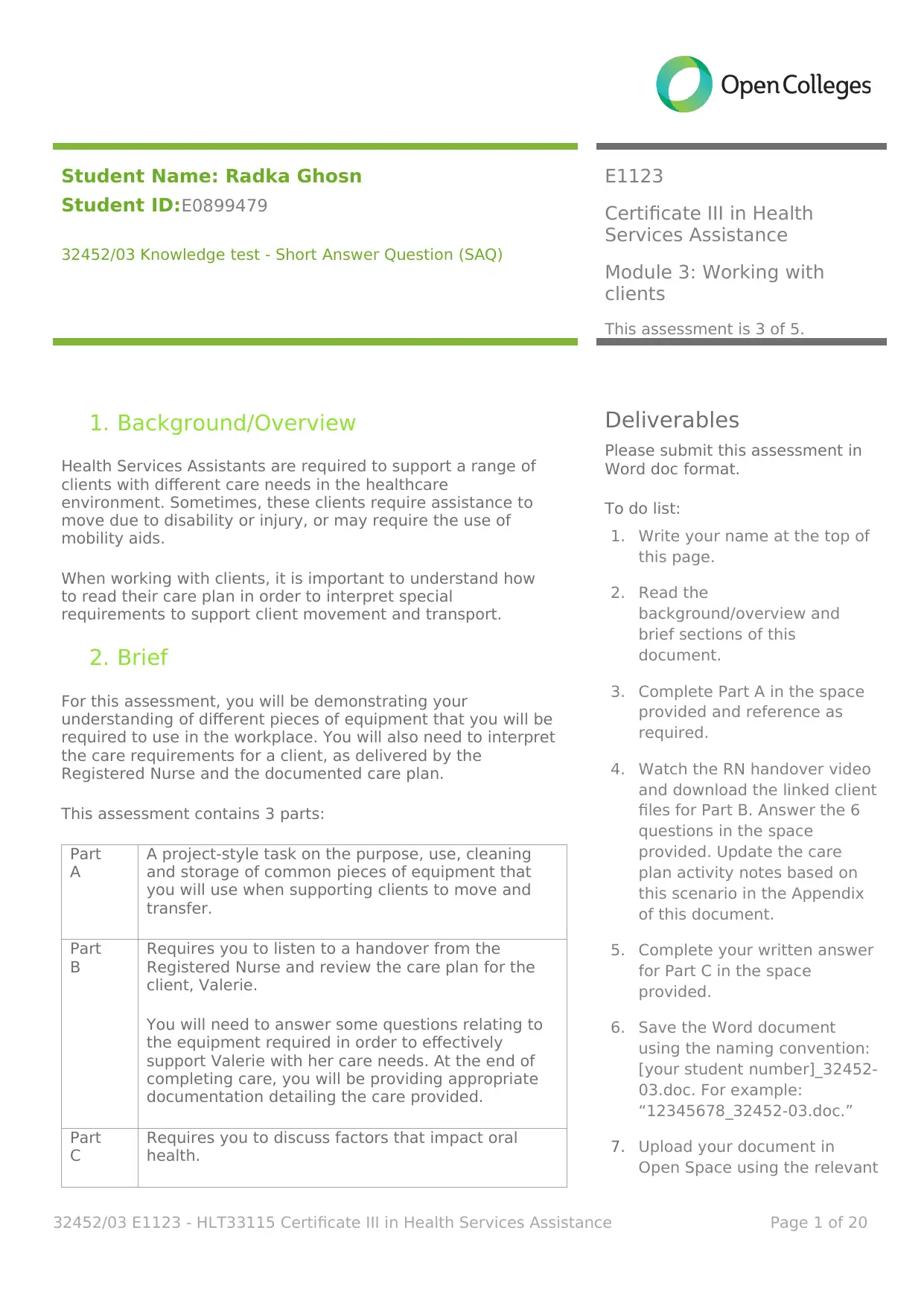
Student Name: Radka Ghosn
Student ID:E0899479
32452/03 Knowledge test - Short Answer Question (SAQ)
E1123
Certificate III in Health
Services Assistance
Module 3: Working with
clients
This assessment is 3 of 5.
1. Background/Overview
Health Services Assistants are required to support a range of
clients with different care needs in the healthcare
environment. Sometimes, these clients require assistance to
move due to disability or injury, or may require the use of
mobility aids.
When working with clients, it is important to understand how
to read their care plan in order to interpret special
requirements to support client movement and transport.
2. Brief
For this assessment, you will be demonstrating your
understanding of different pieces of equipment that you will be
required to use in the workplace. You will also need to interpret
the care requirements for a client, as delivered by the
Registered Nurse and the documented care plan.
This assessment contains 3 parts:
Part
A
A project-style task on the purpose, use, cleaning
and storage of common pieces of equipment that
you will use when supporting clients to move and
transfer.
Part
B
Requires you to listen to a handover from the
Registered Nurse and review the care plan for the
client, Valerie.
You will need to answer some questions relating to
the equipment required in order to effectively
support Valerie with her care needs. At the end of
completing care, you will be providing appropriate
documentation detailing the care provided.
Part
C
Requires you to discuss factors that impact oral
health.
Deliverables
Please submit this assessment in
Word doc format.
To do list:
1. Write your name at the top of
this page.
2. Read the
background/overview and
brief sections of this
document.
3. Complete Part A in the space
provided and reference as
required.
4. Watch the RN handover video
and download the linked client
files for Part B. Answer the 6
questions in the space
provided. Update the care
plan activity notes based on
this scenario in the Appendix
of this document.
5. Complete your written answer
for Part C in the space
provided.
6. Save the Word document
using the naming convention:
[your student number]_32452-
03.doc. For example:
“12345678_32452-03.doc.”
7. Upload your document in
Open Space using the relevant
32452/03 E1123 - HLT33115 Certificate III in Health Services Assistance Page 1 of 20
Student ID:E0899479
32452/03 Knowledge test - Short Answer Question (SAQ)
E1123
Certificate III in Health
Services Assistance
Module 3: Working with
clients
This assessment is 3 of 5.
1. Background/Overview
Health Services Assistants are required to support a range of
clients with different care needs in the healthcare
environment. Sometimes, these clients require assistance to
move due to disability or injury, or may require the use of
mobility aids.
When working with clients, it is important to understand how
to read their care plan in order to interpret special
requirements to support client movement and transport.
2. Brief
For this assessment, you will be demonstrating your
understanding of different pieces of equipment that you will be
required to use in the workplace. You will also need to interpret
the care requirements for a client, as delivered by the
Registered Nurse and the documented care plan.
This assessment contains 3 parts:
Part
A
A project-style task on the purpose, use, cleaning
and storage of common pieces of equipment that
you will use when supporting clients to move and
transfer.
Part
B
Requires you to listen to a handover from the
Registered Nurse and review the care plan for the
client, Valerie.
You will need to answer some questions relating to
the equipment required in order to effectively
support Valerie with her care needs. At the end of
completing care, you will be providing appropriate
documentation detailing the care provided.
Part
C
Requires you to discuss factors that impact oral
health.
Deliverables
Please submit this assessment in
Word doc format.
To do list:
1. Write your name at the top of
this page.
2. Read the
background/overview and
brief sections of this
document.
3. Complete Part A in the space
provided and reference as
required.
4. Watch the RN handover video
and download the linked client
files for Part B. Answer the 6
questions in the space
provided. Update the care
plan activity notes based on
this scenario in the Appendix
of this document.
5. Complete your written answer
for Part C in the space
provided.
6. Save the Word document
using the naming convention:
[your student number]_32452-
03.doc. For example:
“12345678_32452-03.doc.”
7. Upload your document in
Open Space using the relevant
32452/03 E1123 - HLT33115 Certificate III in Health Services Assistance Page 1 of 20
Secure Best Marks with AI Grader
Need help grading? Try our AI Grader for instant feedback on your assignments.
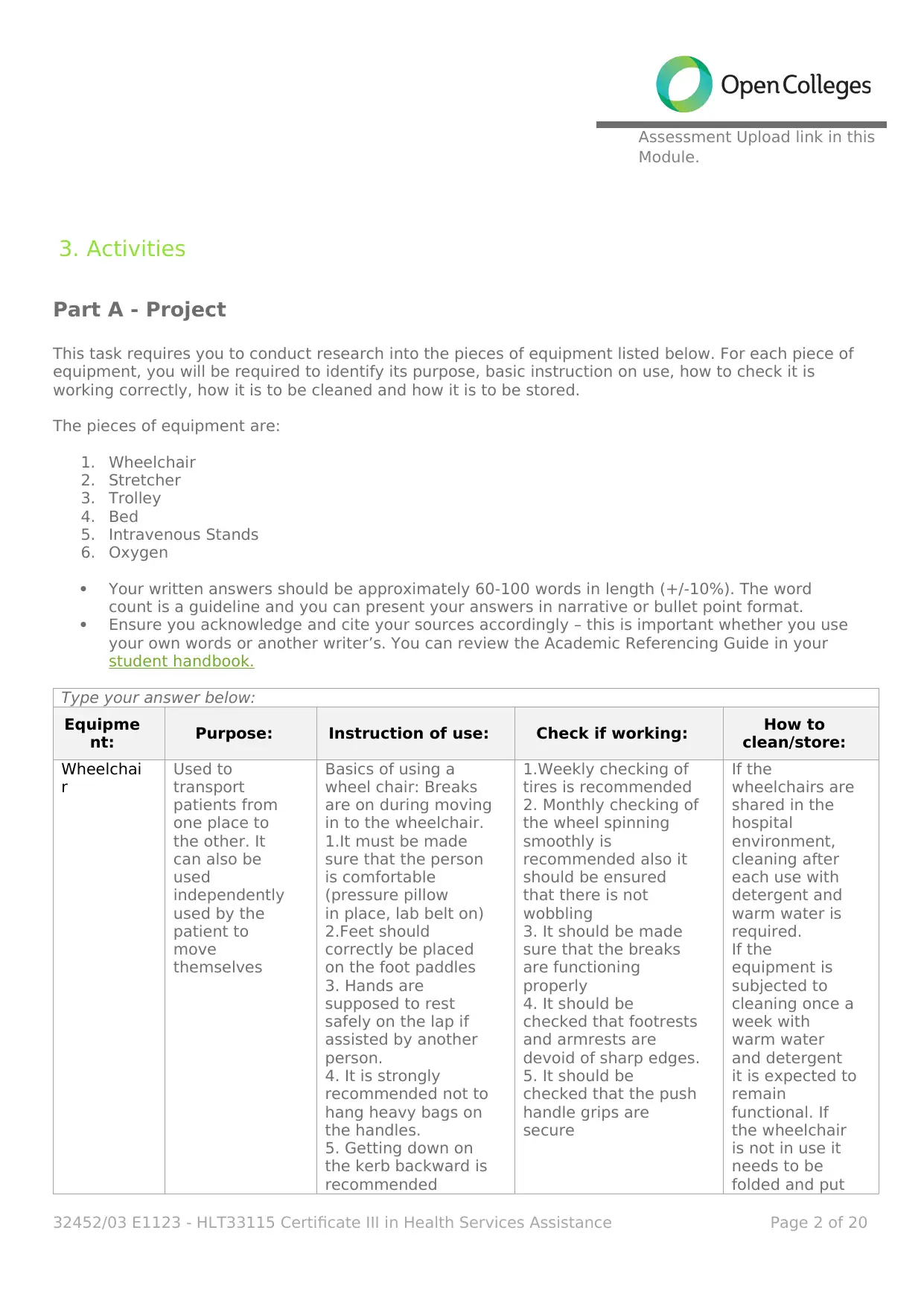
Assessment Upload link in this
Module.
3. Activities
Part A - Project
This task requires you to conduct research into the pieces of equipment listed below. For each piece of
equipment, you will be required to identify its purpose, basic instruction on use, how to check it is
working correctly, how it is to be cleaned and how it is to be stored.
The pieces of equipment are:
1. Wheelchair
2. Stretcher
3. Trolley
4. Bed
5. Intravenous Stands
6. Oxygen
Your written answers should be approximately 60-100 words in length (+/-10%). The word
count is a guideline and you can present your answers in narrative or bullet point format.
Ensure you acknowledge and cite your sources accordingly – this is important whether you use
your own words or another writer’s. You can review the Academic Referencing Guide in your
student handbook.
Type your answer below:
Equipme
nt: Purpose: Instruction of use: Check if working: How to
clean/store:
Wheelchai
r
Used to
transport
patients from
one place to
the other. It
can also be
used
independently
used by the
patient to
move
themselves
Basics of using a
wheel chair: Breaks
are on during moving
in to the wheelchair.
1.It must be made
sure that the person
is comfortable
(pressure pillow
in place, lab belt on)
2.Feet should
correctly be placed
on the foot paddles
3. Hands are
supposed to rest
safely on the lap if
assisted by another
person.
4. It is strongly
recommended not to
hang heavy bags on
the handles.
5. Getting down on
the kerb backward is
recommended
1.Weekly checking of
tires is recommended
2. Monthly checking of
the wheel spinning
smoothly is
recommended also it
should be ensured
that there is not
wobbling
3. It should be made
sure that the breaks
are functioning
properly
4. It should be
checked that footrests
and armrests are
devoid of sharp edges.
5. It should be
checked that the push
handle grips are
secure
If the
wheelchairs are
shared in the
hospital
environment,
cleaning after
each use with
detergent and
warm water is
required.
If the
equipment is
subjected to
cleaning once a
week with
warm water
and detergent
it is expected to
remain
functional. If
the wheelchair
is not in use it
needs to be
folded and put
32452/03 E1123 - HLT33115 Certificate III in Health Services Assistance Page 2 of 20
Module.
3. Activities
Part A - Project
This task requires you to conduct research into the pieces of equipment listed below. For each piece of
equipment, you will be required to identify its purpose, basic instruction on use, how to check it is
working correctly, how it is to be cleaned and how it is to be stored.
The pieces of equipment are:
1. Wheelchair
2. Stretcher
3. Trolley
4. Bed
5. Intravenous Stands
6. Oxygen
Your written answers should be approximately 60-100 words in length (+/-10%). The word
count is a guideline and you can present your answers in narrative or bullet point format.
Ensure you acknowledge and cite your sources accordingly – this is important whether you use
your own words or another writer’s. You can review the Academic Referencing Guide in your
student handbook.
Type your answer below:
Equipme
nt: Purpose: Instruction of use: Check if working: How to
clean/store:
Wheelchai
r
Used to
transport
patients from
one place to
the other. It
can also be
used
independently
used by the
patient to
move
themselves
Basics of using a
wheel chair: Breaks
are on during moving
in to the wheelchair.
1.It must be made
sure that the person
is comfortable
(pressure pillow
in place, lab belt on)
2.Feet should
correctly be placed
on the foot paddles
3. Hands are
supposed to rest
safely on the lap if
assisted by another
person.
4. It is strongly
recommended not to
hang heavy bags on
the handles.
5. Getting down on
the kerb backward is
recommended
1.Weekly checking of
tires is recommended
2. Monthly checking of
the wheel spinning
smoothly is
recommended also it
should be ensured
that there is not
wobbling
3. It should be made
sure that the breaks
are functioning
properly
4. It should be
checked that footrests
and armrests are
devoid of sharp edges.
5. It should be
checked that the push
handle grips are
secure
If the
wheelchairs are
shared in the
hospital
environment,
cleaning after
each use with
detergent and
warm water is
required.
If the
equipment is
subjected to
cleaning once a
week with
warm water
and detergent
it is expected to
remain
functional. If
the wheelchair
is not in use it
needs to be
folded and put
32452/03 E1123 - HLT33115 Certificate III in Health Services Assistance Page 2 of 20

6.Lifting of the
passenger with the
chair or using the
stairs is not
recommended
Source:
(http://www.safety.
uwa.edu.au/incide
nts-injuries-
emergency/first-
aid/wheelchairs/
maintenance-
checklist)
in the safe
place out of the
way of the
patient and
staff to avoid
accidents.
Stretcher
Stretcher is
used for
moving clients
who require
medical care. It
is mostly used
in emergency
situations. A
stretcher must
be carried by
two or more
people.
1.Place patient on
the stretcher
2. Secure the
siderails with the
straps and
accessories into a
safe position
3. Transport patient
carefully
4. Activate wheel
locks or brakes if
needed.
1.organisational
policies and
procedures must be
followed.
2. Paying attention to
the guidance of the
emergency staff while
transferring the client.
3. It is recommended
to use the leg muscles
instead of the back
muscles.
Cleaning after
each use with
detergent and
warm water is
required. The
equipment
must be stored
in the stretcher
cabinets with
enough room
available or it
can also be
safely kept in
special rooms.
Trolley
Used to
transport
clients around
the hospital,
generally from
the ward to
another
department,
for instance
the radiology
or the
emergency
department.
1.It is recommended
to follow the
companies’
procedures and
policies
2. It is also
recommended to
adjust the height of
the trolley to the
appropriate level and
apply brakes
securely prior to the
transfer.
3.It is further
recommended to use
the inclined plane or
the sliding surface to
facilitate easier
transfer.
1. It is advised to
check that the wheels
are running smoothly
and brakes are
working.
2. It should be
checked that the Side
rails can be adjusted
and are not jammed
or blocked
3. It should be
checked that the
height adjustments
can be modified
according to the
requirement
4. It should also be
noted that the casters
and other frame
components are
functioning and are
not rusted or locked
It is
recommended
that the
equipment is
cleaned after
each use with
detergent and
lukewarm
water.
Bed
Beds are
general
equipment in
the room of the
patient where
1.It is
recommended
that the hospital
bed must be
1. It is important to
ensure that before
and after any
adjustment the bed is
capable of moving
1. On account
of high inflow of
the patients,
regular
cleaning of the
32452/03 E1123 - HLT33115 Certificate III in Health Services Assistance Page 3 of 20
passenger with the
chair or using the
stairs is not
recommended
Source:
(http://www.safety.
uwa.edu.au/incide
nts-injuries-
emergency/first-
aid/wheelchairs/
maintenance-
checklist)
in the safe
place out of the
way of the
patient and
staff to avoid
accidents.
Stretcher
Stretcher is
used for
moving clients
who require
medical care. It
is mostly used
in emergency
situations. A
stretcher must
be carried by
two or more
people.
1.Place patient on
the stretcher
2. Secure the
siderails with the
straps and
accessories into a
safe position
3. Transport patient
carefully
4. Activate wheel
locks or brakes if
needed.
1.organisational
policies and
procedures must be
followed.
2. Paying attention to
the guidance of the
emergency staff while
transferring the client.
3. It is recommended
to use the leg muscles
instead of the back
muscles.
Cleaning after
each use with
detergent and
warm water is
required. The
equipment
must be stored
in the stretcher
cabinets with
enough room
available or it
can also be
safely kept in
special rooms.
Trolley
Used to
transport
clients around
the hospital,
generally from
the ward to
another
department,
for instance
the radiology
or the
emergency
department.
1.It is recommended
to follow the
companies’
procedures and
policies
2. It is also
recommended to
adjust the height of
the trolley to the
appropriate level and
apply brakes
securely prior to the
transfer.
3.It is further
recommended to use
the inclined plane or
the sliding surface to
facilitate easier
transfer.
1. It is advised to
check that the wheels
are running smoothly
and brakes are
working.
2. It should be
checked that the Side
rails can be adjusted
and are not jammed
or blocked
3. It should be
checked that the
height adjustments
can be modified
according to the
requirement
4. It should also be
noted that the casters
and other frame
components are
functioning and are
not rusted or locked
It is
recommended
that the
equipment is
cleaned after
each use with
detergent and
lukewarm
water.
Bed
Beds are
general
equipment in
the room of the
patient where
1.It is
recommended
that the hospital
bed must be
1. It is important to
ensure that before
and after any
adjustment the bed is
capable of moving
1. On account
of high inflow of
the patients,
regular
cleaning of the
32452/03 E1123 - HLT33115 Certificate III in Health Services Assistance Page 3 of 20
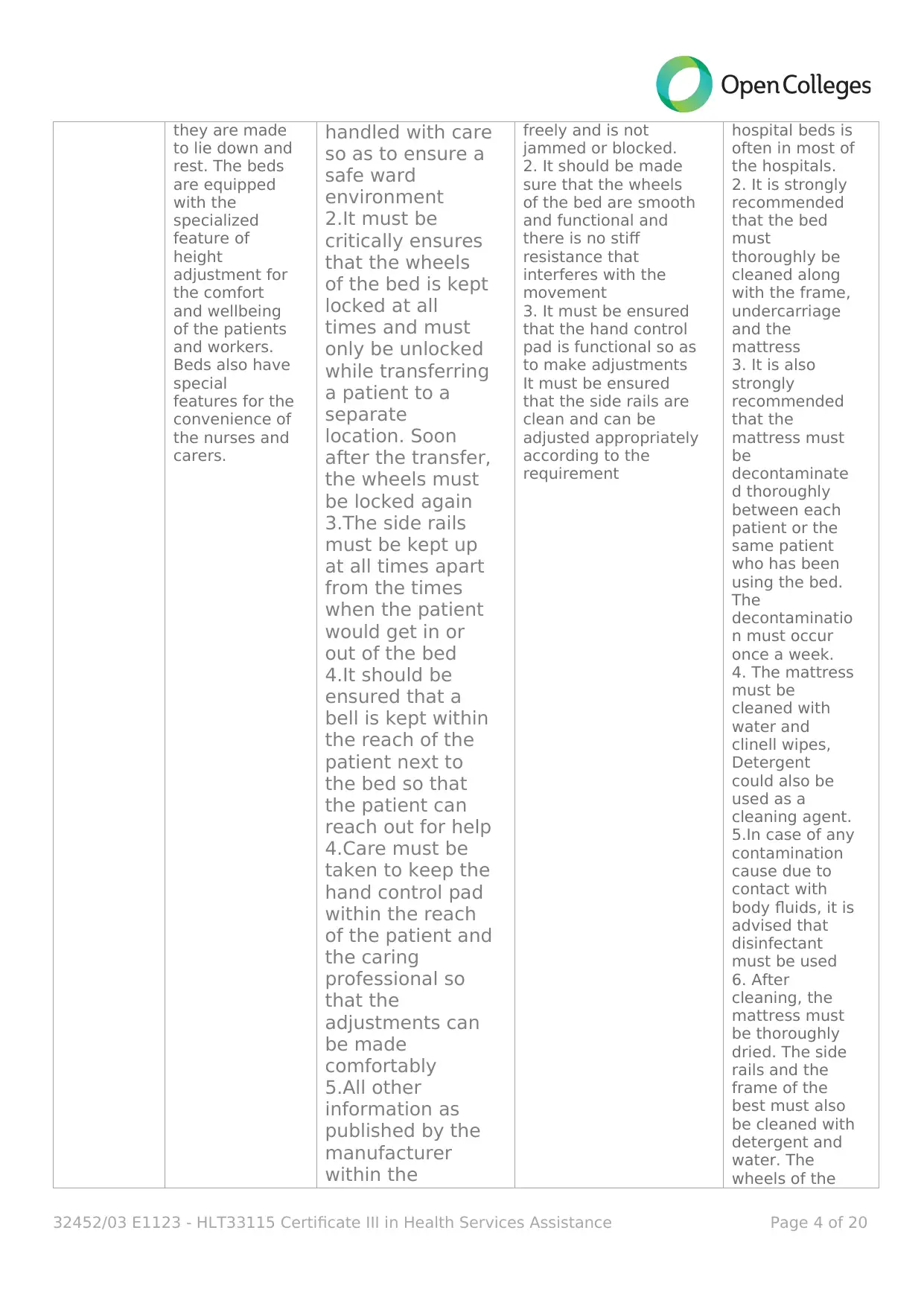
they are made
to lie down and
rest. The beds
are equipped
with the
specialized
feature of
height
adjustment for
the comfort
and wellbeing
of the patients
and workers.
Beds also have
special
features for the
convenience of
the nurses and
carers.
handled with care
so as to ensure a
safe ward
environment
2.It must be
critically ensures
that the wheels
of the bed is kept
locked at all
times and must
only be unlocked
while transferring
a patient to a
separate
location. Soon
after the transfer,
the wheels must
be locked again
3.The side rails
must be kept up
at all times apart
from the times
when the patient
would get in or
out of the bed
4.It should be
ensured that a
bell is kept within
the reach of the
patient next to
the bed so that
the patient can
reach out for help
4.Care must be
taken to keep the
hand control pad
within the reach
of the patient and
the caring
professional so
that the
adjustments can
be made
comfortably
5.All other
information as
published by the
manufacturer
within the
freely and is not
jammed or blocked.
2. It should be made
sure that the wheels
of the bed are smooth
and functional and
there is no stiff
resistance that
interferes with the
movement
3. It must be ensured
that the hand control
pad is functional so as
to make adjustments
It must be ensured
that the side rails are
clean and can be
adjusted appropriately
according to the
requirement
hospital beds is
often in most of
the hospitals.
2. It is strongly
recommended
that the bed
must
thoroughly be
cleaned along
with the frame,
undercarriage
and the
mattress
3. It is also
strongly
recommended
that the
mattress must
be
decontaminate
d thoroughly
between each
patient or the
same patient
who has been
using the bed.
The
decontaminatio
n must occur
once a week.
4. The mattress
must be
cleaned with
water and
clinell wipes,
Detergent
could also be
used as a
cleaning agent.
5.In case of any
contamination
cause due to
contact with
body fluids, it is
advised that
disinfectant
must be used
6. After
cleaning, the
mattress must
be thoroughly
dried. The side
rails and the
frame of the
best must also
be cleaned with
detergent and
water. The
wheels of the
32452/03 E1123 - HLT33115 Certificate III in Health Services Assistance Page 4 of 20
to lie down and
rest. The beds
are equipped
with the
specialized
feature of
height
adjustment for
the comfort
and wellbeing
of the patients
and workers.
Beds also have
special
features for the
convenience of
the nurses and
carers.
handled with care
so as to ensure a
safe ward
environment
2.It must be
critically ensures
that the wheels
of the bed is kept
locked at all
times and must
only be unlocked
while transferring
a patient to a
separate
location. Soon
after the transfer,
the wheels must
be locked again
3.The side rails
must be kept up
at all times apart
from the times
when the patient
would get in or
out of the bed
4.It should be
ensured that a
bell is kept within
the reach of the
patient next to
the bed so that
the patient can
reach out for help
4.Care must be
taken to keep the
hand control pad
within the reach
of the patient and
the caring
professional so
that the
adjustments can
be made
comfortably
5.All other
information as
published by the
manufacturer
within the
freely and is not
jammed or blocked.
2. It should be made
sure that the wheels
of the bed are smooth
and functional and
there is no stiff
resistance that
interferes with the
movement
3. It must be ensured
that the hand control
pad is functional so as
to make adjustments
It must be ensured
that the side rails are
clean and can be
adjusted appropriately
according to the
requirement
hospital beds is
often in most of
the hospitals.
2. It is strongly
recommended
that the bed
must
thoroughly be
cleaned along
with the frame,
undercarriage
and the
mattress
3. It is also
strongly
recommended
that the
mattress must
be
decontaminate
d thoroughly
between each
patient or the
same patient
who has been
using the bed.
The
decontaminatio
n must occur
once a week.
4. The mattress
must be
cleaned with
water and
clinell wipes,
Detergent
could also be
used as a
cleaning agent.
5.In case of any
contamination
cause due to
contact with
body fluids, it is
advised that
disinfectant
must be used
6. After
cleaning, the
mattress must
be thoroughly
dried. The side
rails and the
frame of the
best must also
be cleaned with
detergent and
water. The
wheels of the
32452/03 E1123 - HLT33115 Certificate III in Health Services Assistance Page 4 of 20
Secure Best Marks with AI Grader
Need help grading? Try our AI Grader for instant feedback on your assignments.
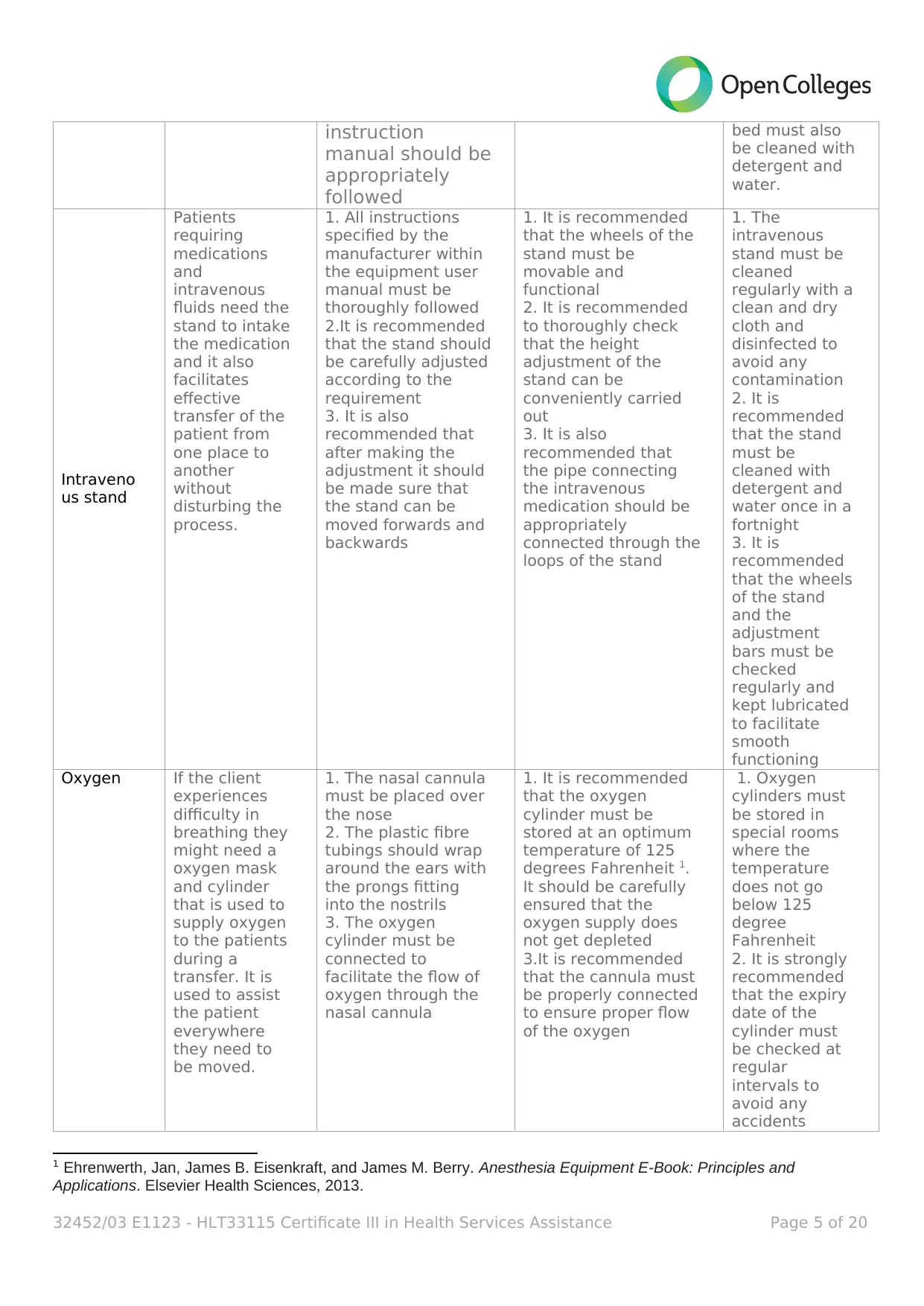
instruction
manual should be
appropriately
followed
bed must also
be cleaned with
detergent and
water.
Intraveno
us stand
Patients
requiring
medications
and
intravenous
fluids need the
stand to intake
the medication
and it also
facilitates
effective
transfer of the
patient from
one place to
another
without
disturbing the
process.
1. All instructions
specified by the
manufacturer within
the equipment user
manual must be
thoroughly followed
2.It is recommended
that the stand should
be carefully adjusted
according to the
requirement
3. It is also
recommended that
after making the
adjustment it should
be made sure that
the stand can be
moved forwards and
backwards
1. It is recommended
that the wheels of the
stand must be
movable and
functional
2. It is recommended
to thoroughly check
that the height
adjustment of the
stand can be
conveniently carried
out
3. It is also
recommended that
the pipe connecting
the intravenous
medication should be
appropriately
connected through the
loops of the stand
1. The
intravenous
stand must be
cleaned
regularly with a
clean and dry
cloth and
disinfected to
avoid any
contamination
2. It is
recommended
that the stand
must be
cleaned with
detergent and
water once in a
fortnight
3. It is
recommended
that the wheels
of the stand
and the
adjustment
bars must be
checked
regularly and
kept lubricated
to facilitate
smooth
functioning
Oxygen If the client
experiences
difficulty in
breathing they
might need a
oxygen mask
and cylinder
that is used to
supply oxygen
to the patients
during a
transfer. It is
used to assist
the patient
everywhere
they need to
be moved.
1. The nasal cannula
must be placed over
the nose
2. The plastic fibre
tubings should wrap
around the ears with
the prongs fitting
into the nostrils
3. The oxygen
cylinder must be
connected to
facilitate the flow of
oxygen through the
nasal cannula
1. It is recommended
that the oxygen
cylinder must be
stored at an optimum
temperature of 125
degrees Fahrenheit 1.
It should be carefully
ensured that the
oxygen supply does
not get depleted
3.It is recommended
that the cannula must
be properly connected
to ensure proper flow
of the oxygen
1. Oxygen
cylinders must
be stored in
special rooms
where the
temperature
does not go
below 125
degree
Fahrenheit
2. It is strongly
recommended
that the expiry
date of the
cylinder must
be checked at
regular
intervals to
avoid any
accidents
1 Ehrenwerth, Jan, James B. Eisenkraft, and James M. Berry. Anesthesia Equipment E-Book: Principles and
Applications. Elsevier Health Sciences, 2013.
32452/03 E1123 - HLT33115 Certificate III in Health Services Assistance Page 5 of 20
manual should be
appropriately
followed
bed must also
be cleaned with
detergent and
water.
Intraveno
us stand
Patients
requiring
medications
and
intravenous
fluids need the
stand to intake
the medication
and it also
facilitates
effective
transfer of the
patient from
one place to
another
without
disturbing the
process.
1. All instructions
specified by the
manufacturer within
the equipment user
manual must be
thoroughly followed
2.It is recommended
that the stand should
be carefully adjusted
according to the
requirement
3. It is also
recommended that
after making the
adjustment it should
be made sure that
the stand can be
moved forwards and
backwards
1. It is recommended
that the wheels of the
stand must be
movable and
functional
2. It is recommended
to thoroughly check
that the height
adjustment of the
stand can be
conveniently carried
out
3. It is also
recommended that
the pipe connecting
the intravenous
medication should be
appropriately
connected through the
loops of the stand
1. The
intravenous
stand must be
cleaned
regularly with a
clean and dry
cloth and
disinfected to
avoid any
contamination
2. It is
recommended
that the stand
must be
cleaned with
detergent and
water once in a
fortnight
3. It is
recommended
that the wheels
of the stand
and the
adjustment
bars must be
checked
regularly and
kept lubricated
to facilitate
smooth
functioning
Oxygen If the client
experiences
difficulty in
breathing they
might need a
oxygen mask
and cylinder
that is used to
supply oxygen
to the patients
during a
transfer. It is
used to assist
the patient
everywhere
they need to
be moved.
1. The nasal cannula
must be placed over
the nose
2. The plastic fibre
tubings should wrap
around the ears with
the prongs fitting
into the nostrils
3. The oxygen
cylinder must be
connected to
facilitate the flow of
oxygen through the
nasal cannula
1. It is recommended
that the oxygen
cylinder must be
stored at an optimum
temperature of 125
degrees Fahrenheit 1.
It should be carefully
ensured that the
oxygen supply does
not get depleted
3.It is recommended
that the cannula must
be properly connected
to ensure proper flow
of the oxygen
1. Oxygen
cylinders must
be stored in
special rooms
where the
temperature
does not go
below 125
degree
Fahrenheit
2. It is strongly
recommended
that the expiry
date of the
cylinder must
be checked at
regular
intervals to
avoid any
accidents
1 Ehrenwerth, Jan, James B. Eisenkraft, and James M. Berry. Anesthesia Equipment E-Book: Principles and
Applications. Elsevier Health Sciences, 2013.
32452/03 E1123 - HLT33115 Certificate III in Health Services Assistance Page 5 of 20
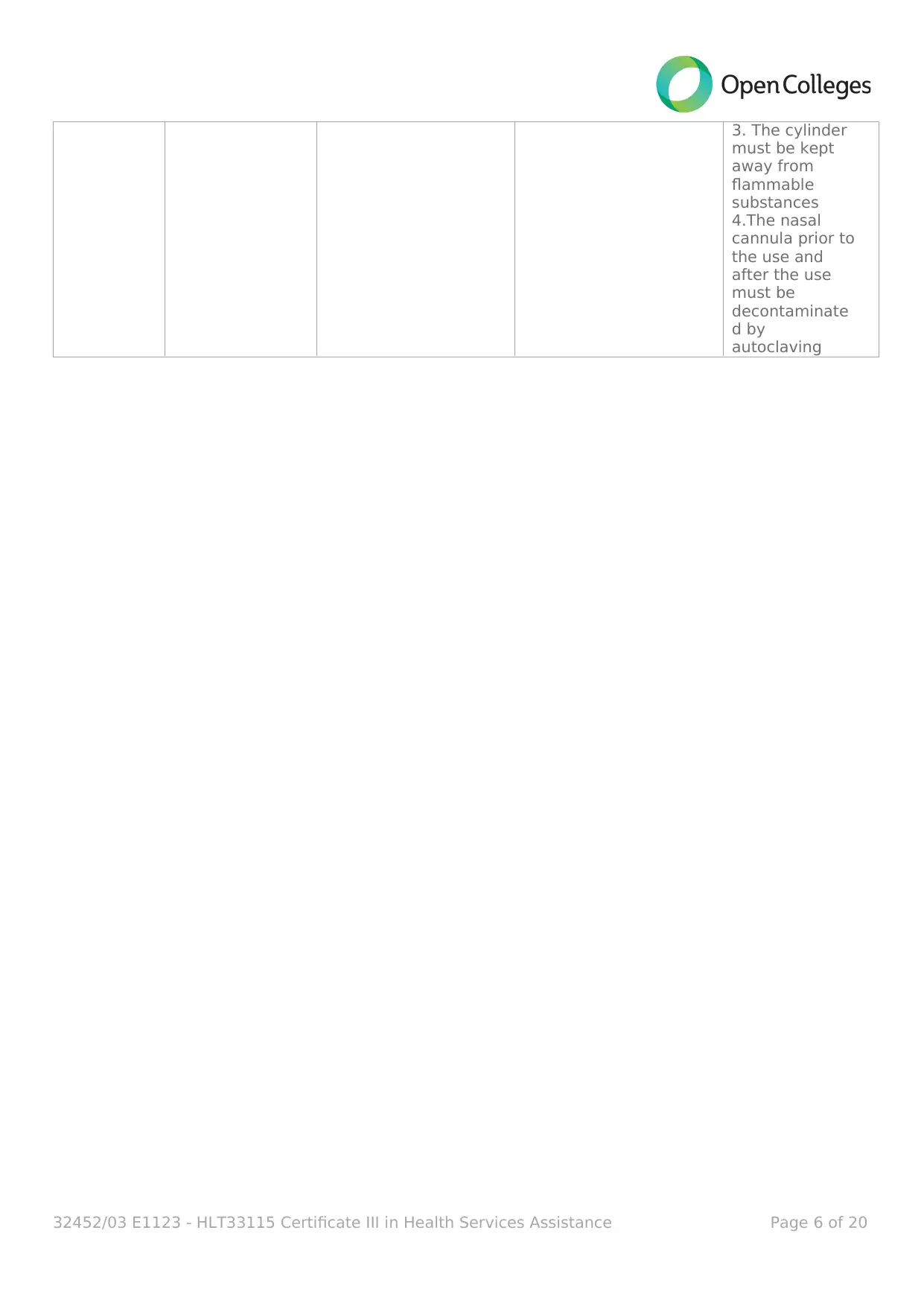
3. The cylinder
must be kept
away from
flammable
substances
4.The nasal
cannula prior to
the use and
after the use
must be
decontaminate
d by
autoclaving
32452/03 E1123 - HLT33115 Certificate III in Health Services Assistance Page 6 of 20
must be kept
away from
flammable
substances
4.The nasal
cannula prior to
the use and
after the use
must be
decontaminate
d by
autoclaving
32452/03 E1123 - HLT33115 Certificate III in Health Services Assistance Page 6 of 20
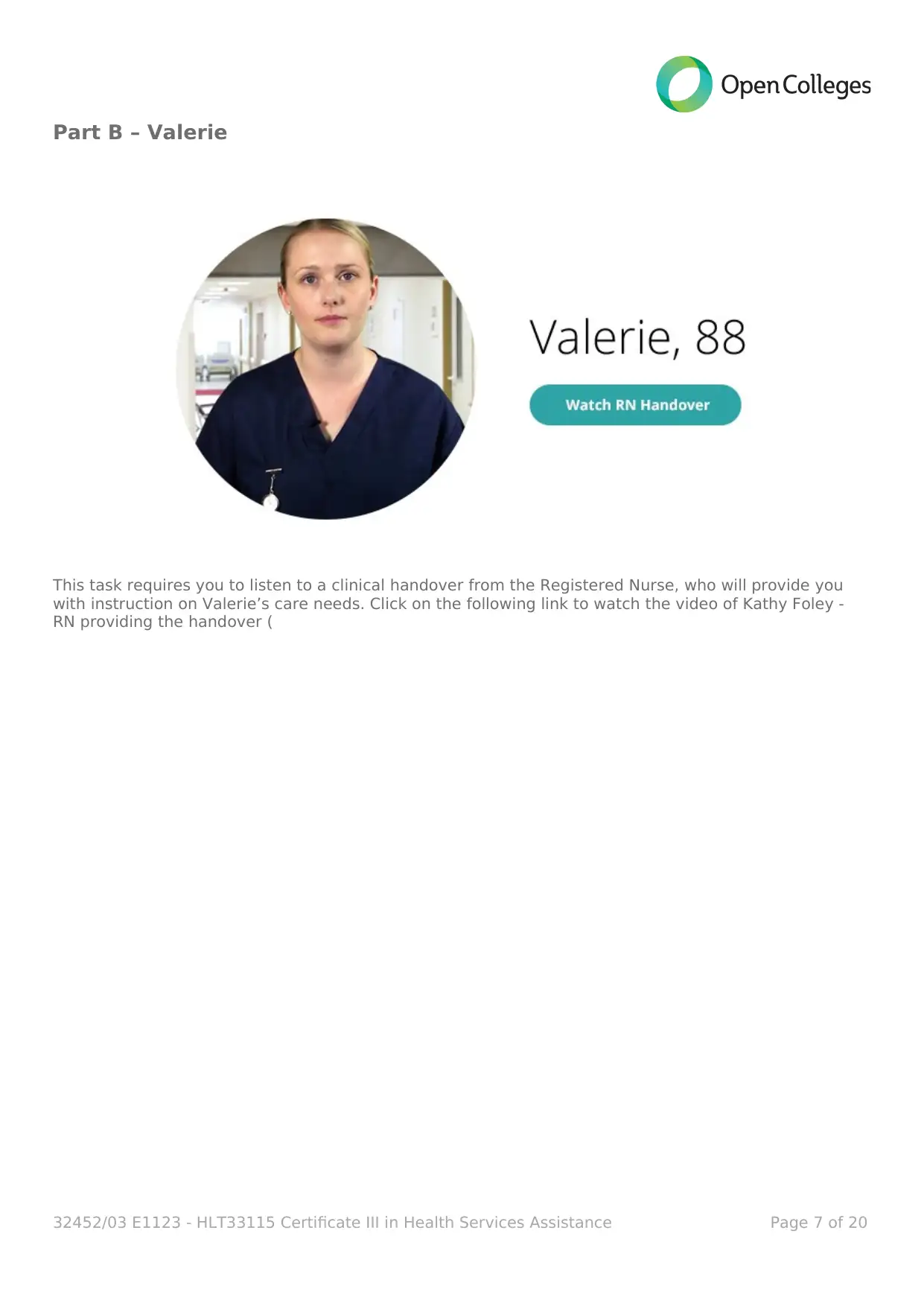
Part B – Valerie
This task requires you to listen to a clinical handover from the Registered Nurse, who will provide you
with instruction on Valerie’s care needs. Click on the following link to watch the video of Kathy Foley -
RN providing the handover (
32452/03 E1123 - HLT33115 Certificate III in Health Services Assistance Page 7 of 20
This task requires you to listen to a clinical handover from the Registered Nurse, who will provide you
with instruction on Valerie’s care needs. Click on the following link to watch the video of Kathy Foley -
RN providing the handover (
32452/03 E1123 - HLT33115 Certificate III in Health Services Assistance Page 7 of 20
Paraphrase This Document
Need a fresh take? Get an instant paraphrase of this document with our AI Paraphraser
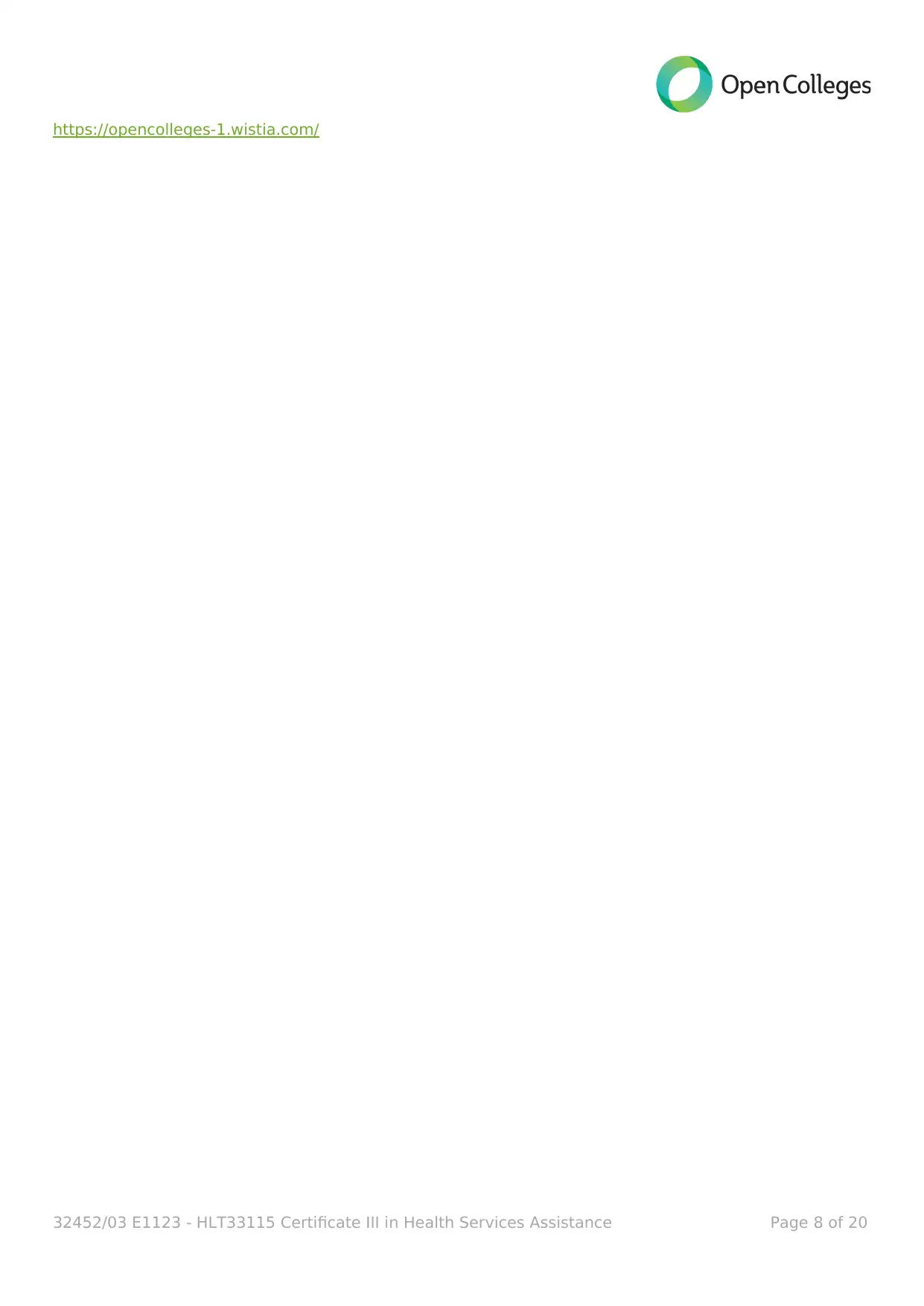
https://opencolleges-1.wistia.com/
32452/03 E1123 - HLT33115 Certificate III in Health Services Assistance Page 8 of 20
32452/03 E1123 - HLT33115 Certificate III in Health Services Assistance Page 8 of 20
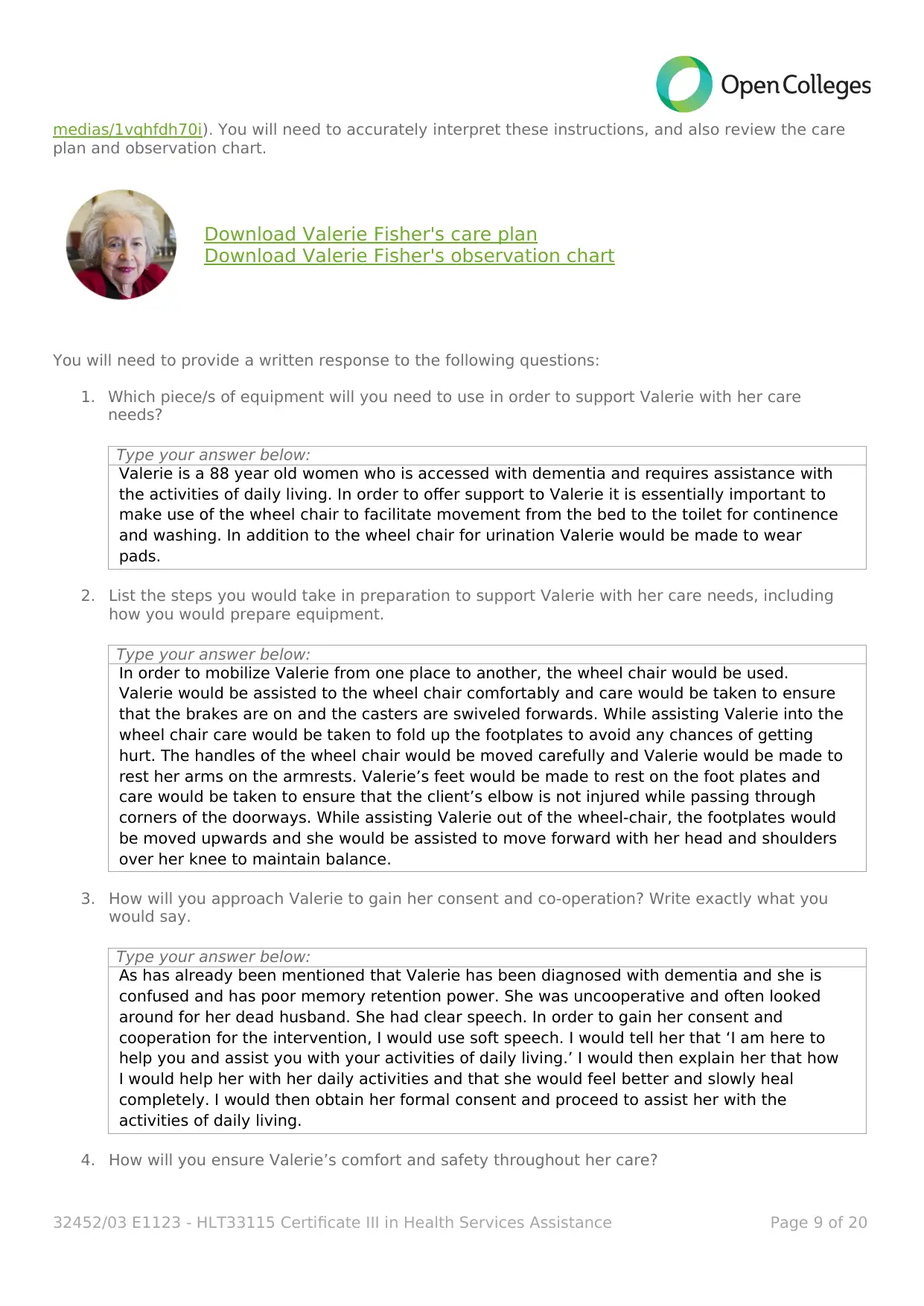
medias/1vqhfdh70i). You will need to accurately interpret these instructions, and also review the care
plan and observation chart.
Download Valerie Fisher's care plan
Download Valerie Fisher's observation chart
You will need to provide a written response to the following questions:
1. Which piece/s of equipment will you need to use in order to support Valerie with her care
needs?
Type your answer below:
Valerie is a 88 year old women who is accessed with dementia and requires assistance with
the activities of daily living. In order to offer support to Valerie it is essentially important to
make use of the wheel chair to facilitate movement from the bed to the toilet for continence
and washing. In addition to the wheel chair for urination Valerie would be made to wear
pads.
2. List the steps you would take in preparation to support Valerie with her care needs, including
how you would prepare equipment.
Type your answer below:
In order to mobilize Valerie from one place to another, the wheel chair would be used.
Valerie would be assisted to the wheel chair comfortably and care would be taken to ensure
that the brakes are on and the casters are swiveled forwards. While assisting Valerie into the
wheel chair care would be taken to fold up the footplates to avoid any chances of getting
hurt. The handles of the wheel chair would be moved carefully and Valerie would be made to
rest her arms on the armrests. Valerie’s feet would be made to rest on the foot plates and
care would be taken to ensure that the client’s elbow is not injured while passing through
corners of the doorways. While assisting Valerie out of the wheel-chair, the footplates would
be moved upwards and she would be assisted to move forward with her head and shoulders
over her knee to maintain balance.
3. How will you approach Valerie to gain her consent and co-operation? Write exactly what you
would say.
Type your answer below:
As has already been mentioned that Valerie has been diagnosed with dementia and she is
confused and has poor memory retention power. She was uncooperative and often looked
around for her dead husband. She had clear speech. In order to gain her consent and
cooperation for the intervention, I would use soft speech. I would tell her that ‘I am here to
help you and assist you with your activities of daily living.’ I would then explain her that how
I would help her with her daily activities and that she would feel better and slowly heal
completely. I would then obtain her formal consent and proceed to assist her with the
activities of daily living.
4. How will you ensure Valerie’s comfort and safety throughout her care?
32452/03 E1123 - HLT33115 Certificate III in Health Services Assistance Page 9 of 20
plan and observation chart.
Download Valerie Fisher's care plan
Download Valerie Fisher's observation chart
You will need to provide a written response to the following questions:
1. Which piece/s of equipment will you need to use in order to support Valerie with her care
needs?
Type your answer below:
Valerie is a 88 year old women who is accessed with dementia and requires assistance with
the activities of daily living. In order to offer support to Valerie it is essentially important to
make use of the wheel chair to facilitate movement from the bed to the toilet for continence
and washing. In addition to the wheel chair for urination Valerie would be made to wear
pads.
2. List the steps you would take in preparation to support Valerie with her care needs, including
how you would prepare equipment.
Type your answer below:
In order to mobilize Valerie from one place to another, the wheel chair would be used.
Valerie would be assisted to the wheel chair comfortably and care would be taken to ensure
that the brakes are on and the casters are swiveled forwards. While assisting Valerie into the
wheel chair care would be taken to fold up the footplates to avoid any chances of getting
hurt. The handles of the wheel chair would be moved carefully and Valerie would be made to
rest her arms on the armrests. Valerie’s feet would be made to rest on the foot plates and
care would be taken to ensure that the client’s elbow is not injured while passing through
corners of the doorways. While assisting Valerie out of the wheel-chair, the footplates would
be moved upwards and she would be assisted to move forward with her head and shoulders
over her knee to maintain balance.
3. How will you approach Valerie to gain her consent and co-operation? Write exactly what you
would say.
Type your answer below:
As has already been mentioned that Valerie has been diagnosed with dementia and she is
confused and has poor memory retention power. She was uncooperative and often looked
around for her dead husband. She had clear speech. In order to gain her consent and
cooperation for the intervention, I would use soft speech. I would tell her that ‘I am here to
help you and assist you with your activities of daily living.’ I would then explain her that how
I would help her with her daily activities and that she would feel better and slowly heal
completely. I would then obtain her formal consent and proceed to assist her with the
activities of daily living.
4. How will you ensure Valerie’s comfort and safety throughout her care?
32452/03 E1123 - HLT33115 Certificate III in Health Services Assistance Page 9 of 20
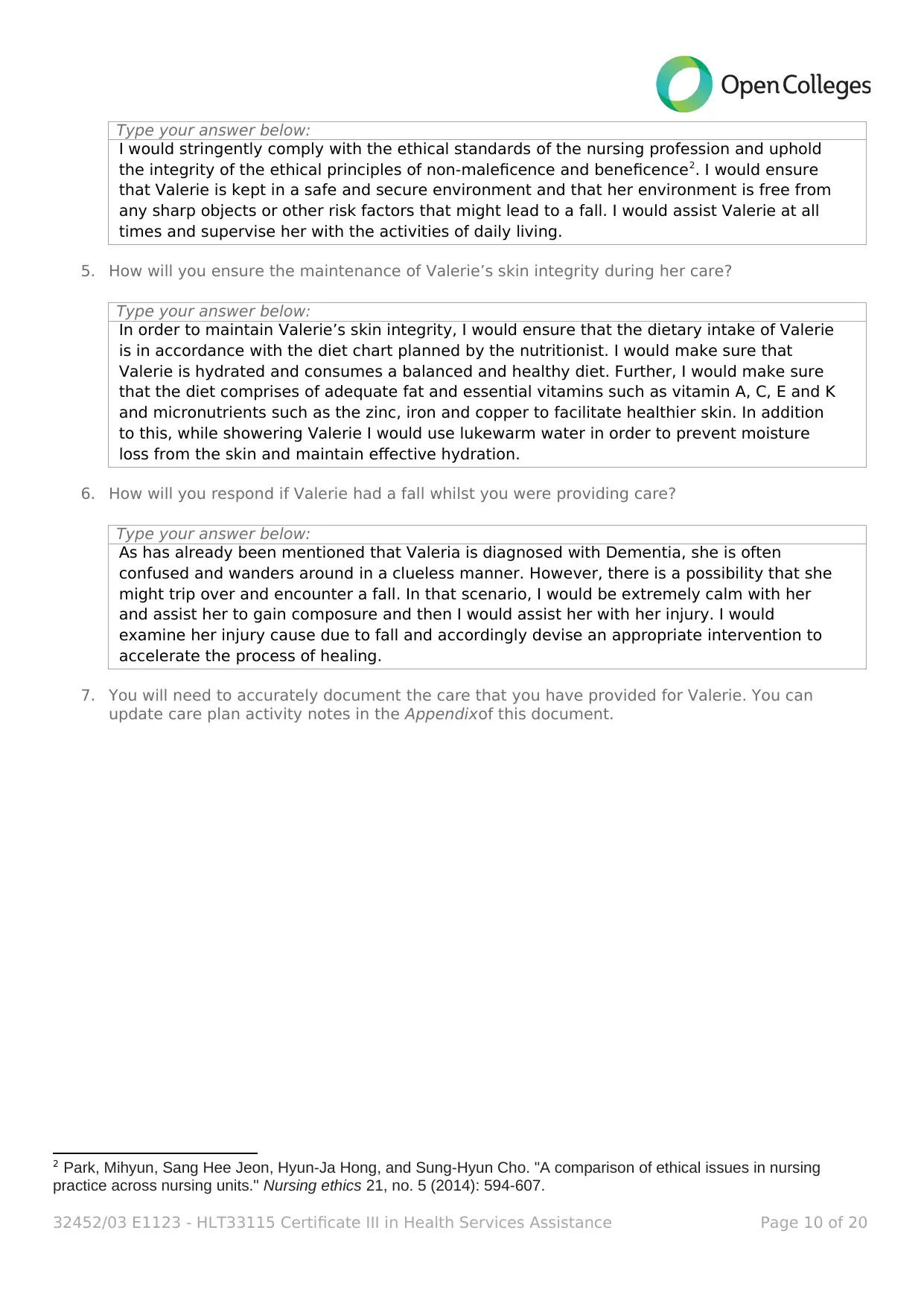
Type your answer below:
I would stringently comply with the ethical standards of the nursing profession and uphold
the integrity of the ethical principles of non-maleficence and beneficence2. I would ensure
that Valerie is kept in a safe and secure environment and that her environment is free from
any sharp objects or other risk factors that might lead to a fall. I would assist Valerie at all
times and supervise her with the activities of daily living.
5. How will you ensure the maintenance of Valerie’s skin integrity during her care?
Type your answer below:
In order to maintain Valerie’s skin integrity, I would ensure that the dietary intake of Valerie
is in accordance with the diet chart planned by the nutritionist. I would make sure that
Valerie is hydrated and consumes a balanced and healthy diet. Further, I would make sure
that the diet comprises of adequate fat and essential vitamins such as vitamin A, C, E and K
and micronutrients such as the zinc, iron and copper to facilitate healthier skin. In addition
to this, while showering Valerie I would use lukewarm water in order to prevent moisture
loss from the skin and maintain effective hydration.
6. How will you respond if Valerie had a fall whilst you were providing care?
Type your answer below:
As has already been mentioned that Valeria is diagnosed with Dementia, she is often
confused and wanders around in a clueless manner. However, there is a possibility that she
might trip over and encounter a fall. In that scenario, I would be extremely calm with her
and assist her to gain composure and then I would assist her with her injury. I would
examine her injury cause due to fall and accordingly devise an appropriate intervention to
accelerate the process of healing.
7. You will need to accurately document the care that you have provided for Valerie. You can
update care plan activity notes in the Appendixof this document.
2 Park, Mihyun, Sang Hee Jeon, Hyun-Ja Hong, and Sung-Hyun Cho. "A comparison of ethical issues in nursing
practice across nursing units." Nursing ethics 21, no. 5 (2014): 594-607.
32452/03 E1123 - HLT33115 Certificate III in Health Services Assistance Page 10 of 20
I would stringently comply with the ethical standards of the nursing profession and uphold
the integrity of the ethical principles of non-maleficence and beneficence2. I would ensure
that Valerie is kept in a safe and secure environment and that her environment is free from
any sharp objects or other risk factors that might lead to a fall. I would assist Valerie at all
times and supervise her with the activities of daily living.
5. How will you ensure the maintenance of Valerie’s skin integrity during her care?
Type your answer below:
In order to maintain Valerie’s skin integrity, I would ensure that the dietary intake of Valerie
is in accordance with the diet chart planned by the nutritionist. I would make sure that
Valerie is hydrated and consumes a balanced and healthy diet. Further, I would make sure
that the diet comprises of adequate fat and essential vitamins such as vitamin A, C, E and K
and micronutrients such as the zinc, iron and copper to facilitate healthier skin. In addition
to this, while showering Valerie I would use lukewarm water in order to prevent moisture
loss from the skin and maintain effective hydration.
6. How will you respond if Valerie had a fall whilst you were providing care?
Type your answer below:
As has already been mentioned that Valeria is diagnosed with Dementia, she is often
confused and wanders around in a clueless manner. However, there is a possibility that she
might trip over and encounter a fall. In that scenario, I would be extremely calm with her
and assist her to gain composure and then I would assist her with her injury. I would
examine her injury cause due to fall and accordingly devise an appropriate intervention to
accelerate the process of healing.
7. You will need to accurately document the care that you have provided for Valerie. You can
update care plan activity notes in the Appendixof this document.
2 Park, Mihyun, Sang Hee Jeon, Hyun-Ja Hong, and Sung-Hyun Cho. "A comparison of ethical issues in nursing
practice across nursing units." Nursing ethics 21, no. 5 (2014): 594-607.
32452/03 E1123 - HLT33115 Certificate III in Health Services Assistance Page 10 of 20
Secure Best Marks with AI Grader
Need help grading? Try our AI Grader for instant feedback on your assignments.

Part C – Factors that impact Oral Health
This task requires you to discuss factors that impact oral health by identifying an example of each
factor, plus a consequence of the factor.
Your written answers should be approximately 20-60 words in length (+/-10%). The word count
is a guideline and you can present your answers in narrative or bullet point format.
Ensure you acknowledge and cite your sources accordingly – this is important whether you use
your own words or another writer’s. You can review the Academic Referencing Guide in your
student handbook.
1. Abuse (neglect of oral health needs)
Type your answer below:
Neglect of oral health leads to dental decay and manifestation of microbes within the oral
cavity. The manifestation of microbes would lead to formation of cavities inside the teeth. In
addition to this, neglect of oral health would lead to oral infection and inflammation of the
gum and it would also infect the dental blood vessels. In addition to this, studies have also
revealed that neglect of oral health would cause bad breath or pyorrhea and mouth ulcer3.
2. Access to dental and health services
Type your answer below:
As health care professionals it is extremely important to endure that access to health care
facilities is not denied to people of any age group. It should further be noted that access to
dental and health services are widely dependent upon the public education and awareness.
As efficient health care professionals it is important to adapt strategies for the awareness of
promotion of health and dental services.
3. Alcohol, licit and illicit drugs and substances, over the counter and herbal treatments
Type your answer below:
Regular consumption of alcohol causes dry mouth and tooth erosion. It should also be noted
that dryness of the mouth is directly proportional to the increase of the risk related to tooth
decay4. On the other hand as revealed by studies, it should be noted that certain groups of
lecit, illicit and herbal drugs also cause dryness of mouth and impairs the normal saliva
functioning5. Saliva plays an important role in neutralizing the role of decay causing mouth
acids and controls the population or oral bacteria
4. Bacteria in dental plaque
Type your answer below:
Manifestation of bacteria leads to the formation of dental cavities and also leads to a
3 Newton, J. Timothy, and Koula Asimakopoulou. "Managing oral hygiene as a risk factor for periodontal disease: a
systematic review of psychological approaches to behaviour change for improved plaque control in periodontal
management." Journal of clinical periodontology 42 (2015): S36-S46.
4 Wade, William G. "The oral microbiome in health and disease." Pharmacological research 69, no. 1 (2013): 137-143.
5 Tsai, Sen‐Tien, Tung‐Yiu Wong, Chun‐Yen Ou, Sheen‐Yie Fang, Ken‐Chung Chen, Jenn‐Ren Hsiao, Cheng‐Chih
Huang et al. "The interplay between alcohol consumption, oral hygiene, ALDH2 and ADH1B in the risk of head and
neck cancer." International journal of cancer 135, no. 10 (2014): 2424-2436.
32452/03 E1123 - HLT33115 Certificate III in Health Services Assistance Page 11 of 20
This task requires you to discuss factors that impact oral health by identifying an example of each
factor, plus a consequence of the factor.
Your written answers should be approximately 20-60 words in length (+/-10%). The word count
is a guideline and you can present your answers in narrative or bullet point format.
Ensure you acknowledge and cite your sources accordingly – this is important whether you use
your own words or another writer’s. You can review the Academic Referencing Guide in your
student handbook.
1. Abuse (neglect of oral health needs)
Type your answer below:
Neglect of oral health leads to dental decay and manifestation of microbes within the oral
cavity. The manifestation of microbes would lead to formation of cavities inside the teeth. In
addition to this, neglect of oral health would lead to oral infection and inflammation of the
gum and it would also infect the dental blood vessels. In addition to this, studies have also
revealed that neglect of oral health would cause bad breath or pyorrhea and mouth ulcer3.
2. Access to dental and health services
Type your answer below:
As health care professionals it is extremely important to endure that access to health care
facilities is not denied to people of any age group. It should further be noted that access to
dental and health services are widely dependent upon the public education and awareness.
As efficient health care professionals it is important to adapt strategies for the awareness of
promotion of health and dental services.
3. Alcohol, licit and illicit drugs and substances, over the counter and herbal treatments
Type your answer below:
Regular consumption of alcohol causes dry mouth and tooth erosion. It should also be noted
that dryness of the mouth is directly proportional to the increase of the risk related to tooth
decay4. On the other hand as revealed by studies, it should be noted that certain groups of
lecit, illicit and herbal drugs also cause dryness of mouth and impairs the normal saliva
functioning5. Saliva plays an important role in neutralizing the role of decay causing mouth
acids and controls the population or oral bacteria
4. Bacteria in dental plaque
Type your answer below:
Manifestation of bacteria leads to the formation of dental cavities and also leads to a
3 Newton, J. Timothy, and Koula Asimakopoulou. "Managing oral hygiene as a risk factor for periodontal disease: a
systematic review of psychological approaches to behaviour change for improved plaque control in periodontal
management." Journal of clinical periodontology 42 (2015): S36-S46.
4 Wade, William G. "The oral microbiome in health and disease." Pharmacological research 69, no. 1 (2013): 137-143.
5 Tsai, Sen‐Tien, Tung‐Yiu Wong, Chun‐Yen Ou, Sheen‐Yie Fang, Ken‐Chung Chen, Jenn‐Ren Hsiao, Cheng‐Chih
Huang et al. "The interplay between alcohol consumption, oral hygiene, ALDH2 and ADH1B in the risk of head and
neck cancer." International journal of cancer 135, no. 10 (2014): 2424-2436.
32452/03 E1123 - HLT33115 Certificate III in Health Services Assistance Page 11 of 20

condition known as carries. Bacterial manifestation in dental plaque degrades the blood
vessels, causes inflammation and causes bad breath.
5. Correct infant feeding practices
Type your answer below:
For infants, it is recommended that a clean, soft, moistened piece of cloth is wrapped around
the index finger with which the gums should be cleaned twice a day. The gums should also
be gently massaged in the same manner and the baby should be fed only at will.
6. Damage from habitual grinding of teeth
Type your answer below:
The habitual grinding of teeth is also referred to as ‘bruxism’ and is detrimental to oral
hygiene. Continous grinding of teeth leads to side-effects such as headache, pain within the
jaw palate and teeth erosion. Teeth erosion might lead to gum injury and oral infection.
7. Diet and nutrition, including fluids and excessive intake of sugar
Type your answer below:
Excessive intake of sugar and sweetened beverages leads to bacterial manifestation. The
bacterial infestation leads to cavities that cause toothache and inflammation of the gums.
Hence, diet and nutrition play an important role in the maintenance of oral hygiene.
8. Fluoride
Type your answer below:
Excessive intake of Fluoride leads to enamel fluorosis. The condition is characterized by the
appearance of brown striation on the enamel and brittle teeth that impedes with the normal
functioning of the teeth.
9. General health and wellbeing
Type your answer below:
General health and wellbeing is extremely important for the promotion of positive health.
Maintenance of proper oral health and hygiene and adapting a healthy lifestyle helps in
adding up healthier and happier years to life.
10. Immunosuppressant conditions, HIV, chemotherapy and radiation
Type your answer below:
Immunosuppressant conditions such as the condition of HIV characterized by chemotherapy
and radiation as intervention leads to a weakened response of the immune system6. Side-
effects of chemotherapy include hair fall and lose skin and lose teeth. Hence, care should be
taken to assist patients with immunosuppressant conditions and take care of their well
6 da Cruz Campos, Maria Ines, Celso Neiva Campos, Fernando Monteiro Aarestrup, and Beatriz Julião Vieira
Aarestrup. "Oral mucositis in cancer treatment: Natural history, prevention and treatment." Molecular and clinical
oncology 2, no. 3 (2014): 337-340.
32452/03 E1123 - HLT33115 Certificate III in Health Services Assistance Page 12 of 20
vessels, causes inflammation and causes bad breath.
5. Correct infant feeding practices
Type your answer below:
For infants, it is recommended that a clean, soft, moistened piece of cloth is wrapped around
the index finger with which the gums should be cleaned twice a day. The gums should also
be gently massaged in the same manner and the baby should be fed only at will.
6. Damage from habitual grinding of teeth
Type your answer below:
The habitual grinding of teeth is also referred to as ‘bruxism’ and is detrimental to oral
hygiene. Continous grinding of teeth leads to side-effects such as headache, pain within the
jaw palate and teeth erosion. Teeth erosion might lead to gum injury and oral infection.
7. Diet and nutrition, including fluids and excessive intake of sugar
Type your answer below:
Excessive intake of sugar and sweetened beverages leads to bacterial manifestation. The
bacterial infestation leads to cavities that cause toothache and inflammation of the gums.
Hence, diet and nutrition play an important role in the maintenance of oral hygiene.
8. Fluoride
Type your answer below:
Excessive intake of Fluoride leads to enamel fluorosis. The condition is characterized by the
appearance of brown striation on the enamel and brittle teeth that impedes with the normal
functioning of the teeth.
9. General health and wellbeing
Type your answer below:
General health and wellbeing is extremely important for the promotion of positive health.
Maintenance of proper oral health and hygiene and adapting a healthy lifestyle helps in
adding up healthier and happier years to life.
10. Immunosuppressant conditions, HIV, chemotherapy and radiation
Type your answer below:
Immunosuppressant conditions such as the condition of HIV characterized by chemotherapy
and radiation as intervention leads to a weakened response of the immune system6. Side-
effects of chemotherapy include hair fall and lose skin and lose teeth. Hence, care should be
taken to assist patients with immunosuppressant conditions and take care of their well
6 da Cruz Campos, Maria Ines, Celso Neiva Campos, Fernando Monteiro Aarestrup, and Beatriz Julião Vieira
Aarestrup. "Oral mucositis in cancer treatment: Natural history, prevention and treatment." Molecular and clinical
oncology 2, no. 3 (2014): 337-340.
32452/03 E1123 - HLT33115 Certificate III in Health Services Assistance Page 12 of 20

being.
11. Injury to mouth, such as from a seizure
Type your answer below:
Injury to mouth from epileptic seizure can cause complete destruction of the teeth. The
teeth might crack or break because during a seizure people have a tendency to hurt
themselves or chew on their saliva and gums. Immediate first aid can help in saving the
fatal condition.
12. Medical history
Type your answer below:
Family history of dental decay or mouth ulcer makes the future generation susceptible to
oral infections. On many occasions misalignment of the set of teeth repeats itself across
several generations and hence in such a case it is advised that treatment should be sought.
13. Oral piercings
Type your answer below:
Oral piercings such as gum-piercings and tongue piercings increase the risk of oral
infections7. It should also be noted that in case of getting piercings it is important to get it
from a place that uses authentic products. Further, oral hygiene should be practiced on a
regular basis to avoid infections.
14. Patient oral health information
Type your answer below:
It is mandatory to provide oral information to patients in order to equip them with education
and awareness so that they can appropriately maintain oral hygiene.
15. Psychological issues, such as fear of being seen without dentures or persisting with ill-fitting
dentures for satisfaction of others
Type your answer below:
Psychological issues such as being seen with braces or dentures that would compromise
with aesthetic beauty causes psychological stress. Hence, it is important for carers to
consider every aspect of patient comfort and proceed with the intervention
16. Salivary function
Type your answer below:
Impaired salivary function has been reported to cause dryness of the mouth. Impaired
salivary function also leads to problems such as excessive microbial growth and bad breath
7 Hennequin‐Hoenderdos, N. L., D. E. Slot, and G. A. Van der Weijden. "The incidence of complications associated
with lip and/or tongue piercings: a systematic review." International journal of dental hygiene 14, no. 1 (2016): 62-73.
32452/03 E1123 - HLT33115 Certificate III in Health Services Assistance Page 13 of 20
11. Injury to mouth, such as from a seizure
Type your answer below:
Injury to mouth from epileptic seizure can cause complete destruction of the teeth. The
teeth might crack or break because during a seizure people have a tendency to hurt
themselves or chew on their saliva and gums. Immediate first aid can help in saving the
fatal condition.
12. Medical history
Type your answer below:
Family history of dental decay or mouth ulcer makes the future generation susceptible to
oral infections. On many occasions misalignment of the set of teeth repeats itself across
several generations and hence in such a case it is advised that treatment should be sought.
13. Oral piercings
Type your answer below:
Oral piercings such as gum-piercings and tongue piercings increase the risk of oral
infections7. It should also be noted that in case of getting piercings it is important to get it
from a place that uses authentic products. Further, oral hygiene should be practiced on a
regular basis to avoid infections.
14. Patient oral health information
Type your answer below:
It is mandatory to provide oral information to patients in order to equip them with education
and awareness so that they can appropriately maintain oral hygiene.
15. Psychological issues, such as fear of being seen without dentures or persisting with ill-fitting
dentures for satisfaction of others
Type your answer below:
Psychological issues such as being seen with braces or dentures that would compromise
with aesthetic beauty causes psychological stress. Hence, it is important for carers to
consider every aspect of patient comfort and proceed with the intervention
16. Salivary function
Type your answer below:
Impaired salivary function has been reported to cause dryness of the mouth. Impaired
salivary function also leads to problems such as excessive microbial growth and bad breath
7 Hennequin‐Hoenderdos, N. L., D. E. Slot, and G. A. Van der Weijden. "The incidence of complications associated
with lip and/or tongue piercings: a systematic review." International journal of dental hygiene 14, no. 1 (2016): 62-73.
32452/03 E1123 - HLT33115 Certificate III in Health Services Assistance Page 13 of 20
Paraphrase This Document
Need a fresh take? Get an instant paraphrase of this document with our AI Paraphraser
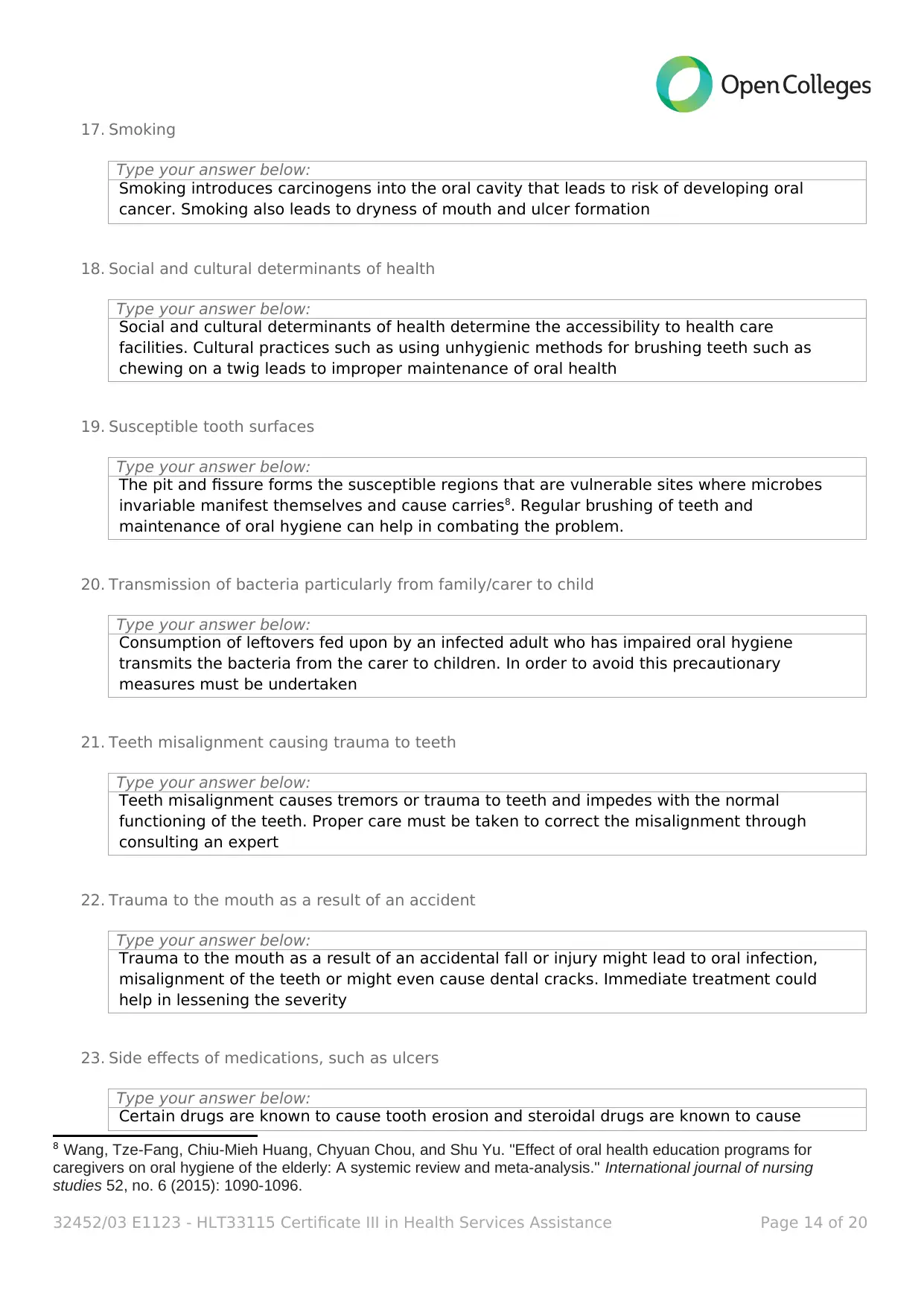
17. Smoking
Type your answer below:
Smoking introduces carcinogens into the oral cavity that leads to risk of developing oral
cancer. Smoking also leads to dryness of mouth and ulcer formation
18. Social and cultural determinants of health
Type your answer below:
Social and cultural determinants of health determine the accessibility to health care
facilities. Cultural practices such as using unhygienic methods for brushing teeth such as
chewing on a twig leads to improper maintenance of oral health
19. Susceptible tooth surfaces
Type your answer below:
The pit and fissure forms the susceptible regions that are vulnerable sites where microbes
invariable manifest themselves and cause carries8. Regular brushing of teeth and
maintenance of oral hygiene can help in combating the problem.
20. Transmission of bacteria particularly from family/carer to child
Type your answer below:
Consumption of leftovers fed upon by an infected adult who has impaired oral hygiene
transmits the bacteria from the carer to children. In order to avoid this precautionary
measures must be undertaken
21. Teeth misalignment causing trauma to teeth
Type your answer below:
Teeth misalignment causes tremors or trauma to teeth and impedes with the normal
functioning of the teeth. Proper care must be taken to correct the misalignment through
consulting an expert
22. Trauma to the mouth as a result of an accident
Type your answer below:
Trauma to the mouth as a result of an accidental fall or injury might lead to oral infection,
misalignment of the teeth or might even cause dental cracks. Immediate treatment could
help in lessening the severity
23. Side effects of medications, such as ulcers
Type your answer below:
Certain drugs are known to cause tooth erosion and steroidal drugs are known to cause
8 Wang, Tze-Fang, Chiu-Mieh Huang, Chyuan Chou, and Shu Yu. "Effect of oral health education programs for
caregivers on oral hygiene of the elderly: A systemic review and meta-analysis." International journal of nursing
studies 52, no. 6 (2015): 1090-1096.
32452/03 E1123 - HLT33115 Certificate III in Health Services Assistance Page 14 of 20
Type your answer below:
Smoking introduces carcinogens into the oral cavity that leads to risk of developing oral
cancer. Smoking also leads to dryness of mouth and ulcer formation
18. Social and cultural determinants of health
Type your answer below:
Social and cultural determinants of health determine the accessibility to health care
facilities. Cultural practices such as using unhygienic methods for brushing teeth such as
chewing on a twig leads to improper maintenance of oral health
19. Susceptible tooth surfaces
Type your answer below:
The pit and fissure forms the susceptible regions that are vulnerable sites where microbes
invariable manifest themselves and cause carries8. Regular brushing of teeth and
maintenance of oral hygiene can help in combating the problem.
20. Transmission of bacteria particularly from family/carer to child
Type your answer below:
Consumption of leftovers fed upon by an infected adult who has impaired oral hygiene
transmits the bacteria from the carer to children. In order to avoid this precautionary
measures must be undertaken
21. Teeth misalignment causing trauma to teeth
Type your answer below:
Teeth misalignment causes tremors or trauma to teeth and impedes with the normal
functioning of the teeth. Proper care must be taken to correct the misalignment through
consulting an expert
22. Trauma to the mouth as a result of an accident
Type your answer below:
Trauma to the mouth as a result of an accidental fall or injury might lead to oral infection,
misalignment of the teeth or might even cause dental cracks. Immediate treatment could
help in lessening the severity
23. Side effects of medications, such as ulcers
Type your answer below:
Certain drugs are known to cause tooth erosion and steroidal drugs are known to cause
8 Wang, Tze-Fang, Chiu-Mieh Huang, Chyuan Chou, and Shu Yu. "Effect of oral health education programs for
caregivers on oral hygiene of the elderly: A systemic review and meta-analysis." International journal of nursing
studies 52, no. 6 (2015): 1090-1096.
32452/03 E1123 - HLT33115 Certificate III in Health Services Assistance Page 14 of 20
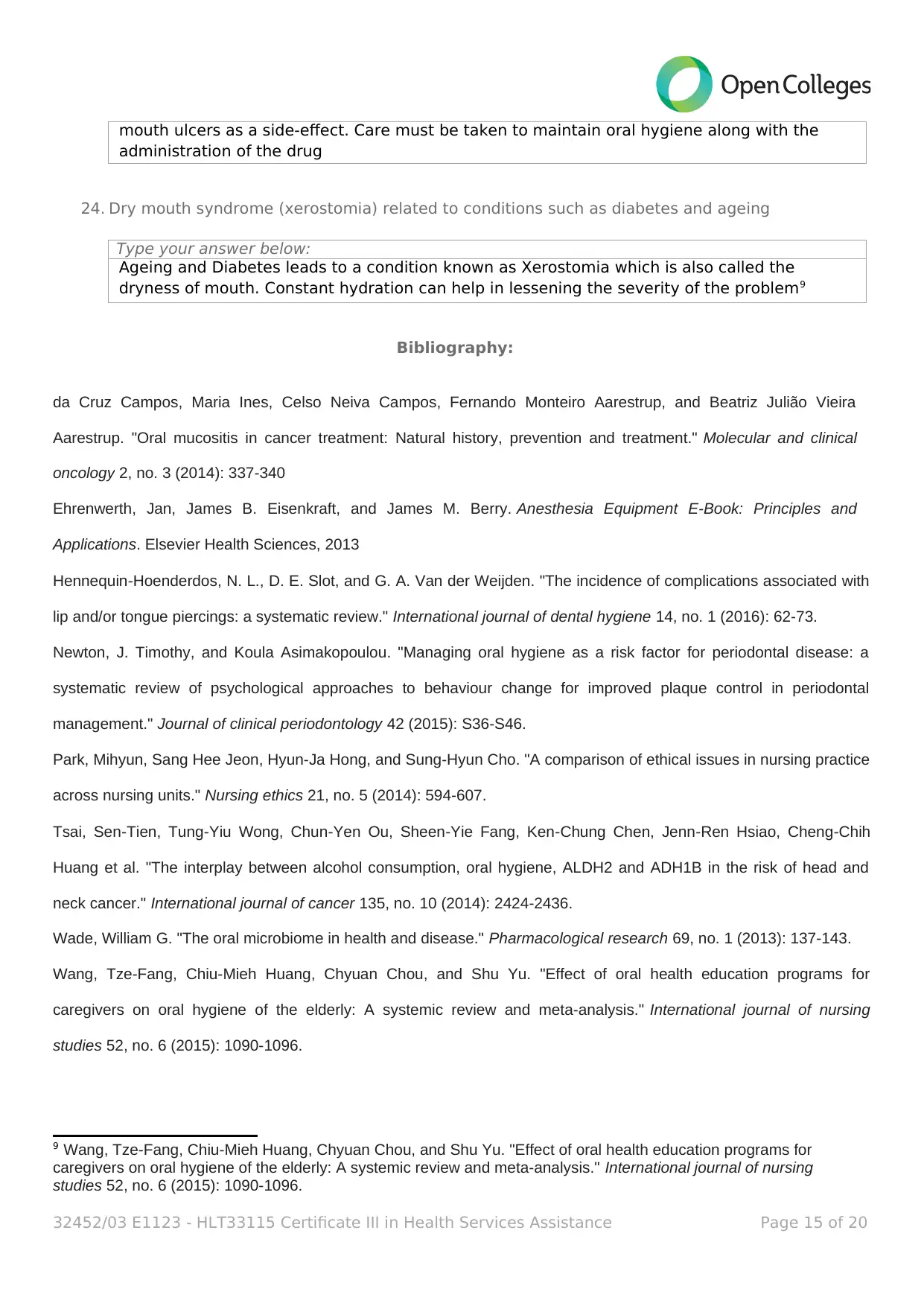
mouth ulcers as a side-effect. Care must be taken to maintain oral hygiene along with the
administration of the drug
24. Dry mouth syndrome (xerostomia) related to conditions such as diabetes and ageing
Type your answer below:
Ageing and Diabetes leads to a condition known as Xerostomia which is also called the
dryness of mouth. Constant hydration can help in lessening the severity of the problem9
Bibliography:
da Cruz Campos, Maria Ines, Celso Neiva Campos, Fernando Monteiro Aarestrup, and Beatriz Julião Vieira
Aarestrup. "Oral mucositis in cancer treatment: Natural history, prevention and treatment." Molecular and clinical
oncology 2, no. 3 (2014): 337-340
Ehrenwerth, Jan, James B. Eisenkraft, and James M. Berry. Anesthesia Equipment E-Book: Principles and
Applications. Elsevier Health Sciences, 2013
Hennequin‐Hoenderdos, N. L., D. E. Slot, and G. A. Van der Weijden. "The incidence of complications associated with
lip and/or tongue piercings: a systematic review." International journal of dental hygiene 14, no. 1 (2016): 62-73.
Newton, J. Timothy, and Koula Asimakopoulou. "Managing oral hygiene as a risk factor for periodontal disease: a
systematic review of psychological approaches to behaviour change for improved plaque control in periodontal
management." Journal of clinical periodontology 42 (2015): S36-S46.
Park, Mihyun, Sang Hee Jeon, Hyun-Ja Hong, and Sung-Hyun Cho. "A comparison of ethical issues in nursing practice
across nursing units." Nursing ethics 21, no. 5 (2014): 594-607.
Tsai, Sen‐Tien, Tung‐Yiu Wong, Chun‐Yen Ou, Sheen‐Yie Fang, Ken‐Chung Chen, Jenn‐Ren Hsiao, Cheng‐Chih
Huang et al. "The interplay between alcohol consumption, oral hygiene, ALDH2 and ADH1B in the risk of head and
neck cancer." International journal of cancer 135, no. 10 (2014): 2424-2436.
Wade, William G. "The oral microbiome in health and disease." Pharmacological research 69, no. 1 (2013): 137-143.
Wang, Tze-Fang, Chiu-Mieh Huang, Chyuan Chou, and Shu Yu. "Effect of oral health education programs for
caregivers on oral hygiene of the elderly: A systemic review and meta-analysis." International journal of nursing
studies 52, no. 6 (2015): 1090-1096.
9 Wang, Tze-Fang, Chiu-Mieh Huang, Chyuan Chou, and Shu Yu. "Effect of oral health education programs for
caregivers on oral hygiene of the elderly: A systemic review and meta-analysis." International journal of nursing
studies 52, no. 6 (2015): 1090-1096.
32452/03 E1123 - HLT33115 Certificate III in Health Services Assistance Page 15 of 20
administration of the drug
24. Dry mouth syndrome (xerostomia) related to conditions such as diabetes and ageing
Type your answer below:
Ageing and Diabetes leads to a condition known as Xerostomia which is also called the
dryness of mouth. Constant hydration can help in lessening the severity of the problem9
Bibliography:
da Cruz Campos, Maria Ines, Celso Neiva Campos, Fernando Monteiro Aarestrup, and Beatriz Julião Vieira
Aarestrup. "Oral mucositis in cancer treatment: Natural history, prevention and treatment." Molecular and clinical
oncology 2, no. 3 (2014): 337-340
Ehrenwerth, Jan, James B. Eisenkraft, and James M. Berry. Anesthesia Equipment E-Book: Principles and
Applications. Elsevier Health Sciences, 2013
Hennequin‐Hoenderdos, N. L., D. E. Slot, and G. A. Van der Weijden. "The incidence of complications associated with
lip and/or tongue piercings: a systematic review." International journal of dental hygiene 14, no. 1 (2016): 62-73.
Newton, J. Timothy, and Koula Asimakopoulou. "Managing oral hygiene as a risk factor for periodontal disease: a
systematic review of psychological approaches to behaviour change for improved plaque control in periodontal
management." Journal of clinical periodontology 42 (2015): S36-S46.
Park, Mihyun, Sang Hee Jeon, Hyun-Ja Hong, and Sung-Hyun Cho. "A comparison of ethical issues in nursing practice
across nursing units." Nursing ethics 21, no. 5 (2014): 594-607.
Tsai, Sen‐Tien, Tung‐Yiu Wong, Chun‐Yen Ou, Sheen‐Yie Fang, Ken‐Chung Chen, Jenn‐Ren Hsiao, Cheng‐Chih
Huang et al. "The interplay between alcohol consumption, oral hygiene, ALDH2 and ADH1B in the risk of head and
neck cancer." International journal of cancer 135, no. 10 (2014): 2424-2436.
Wade, William G. "The oral microbiome in health and disease." Pharmacological research 69, no. 1 (2013): 137-143.
Wang, Tze-Fang, Chiu-Mieh Huang, Chyuan Chou, and Shu Yu. "Effect of oral health education programs for
caregivers on oral hygiene of the elderly: A systemic review and meta-analysis." International journal of nursing
studies 52, no. 6 (2015): 1090-1096.
9 Wang, Tze-Fang, Chiu-Mieh Huang, Chyuan Chou, and Shu Yu. "Effect of oral health education programs for
caregivers on oral hygiene of the elderly: A systemic review and meta-analysis." International journal of nursing
studies 52, no. 6 (2015): 1090-1096.
32452/03 E1123 - HLT33115 Certificate III in Health Services Assistance Page 15 of 20
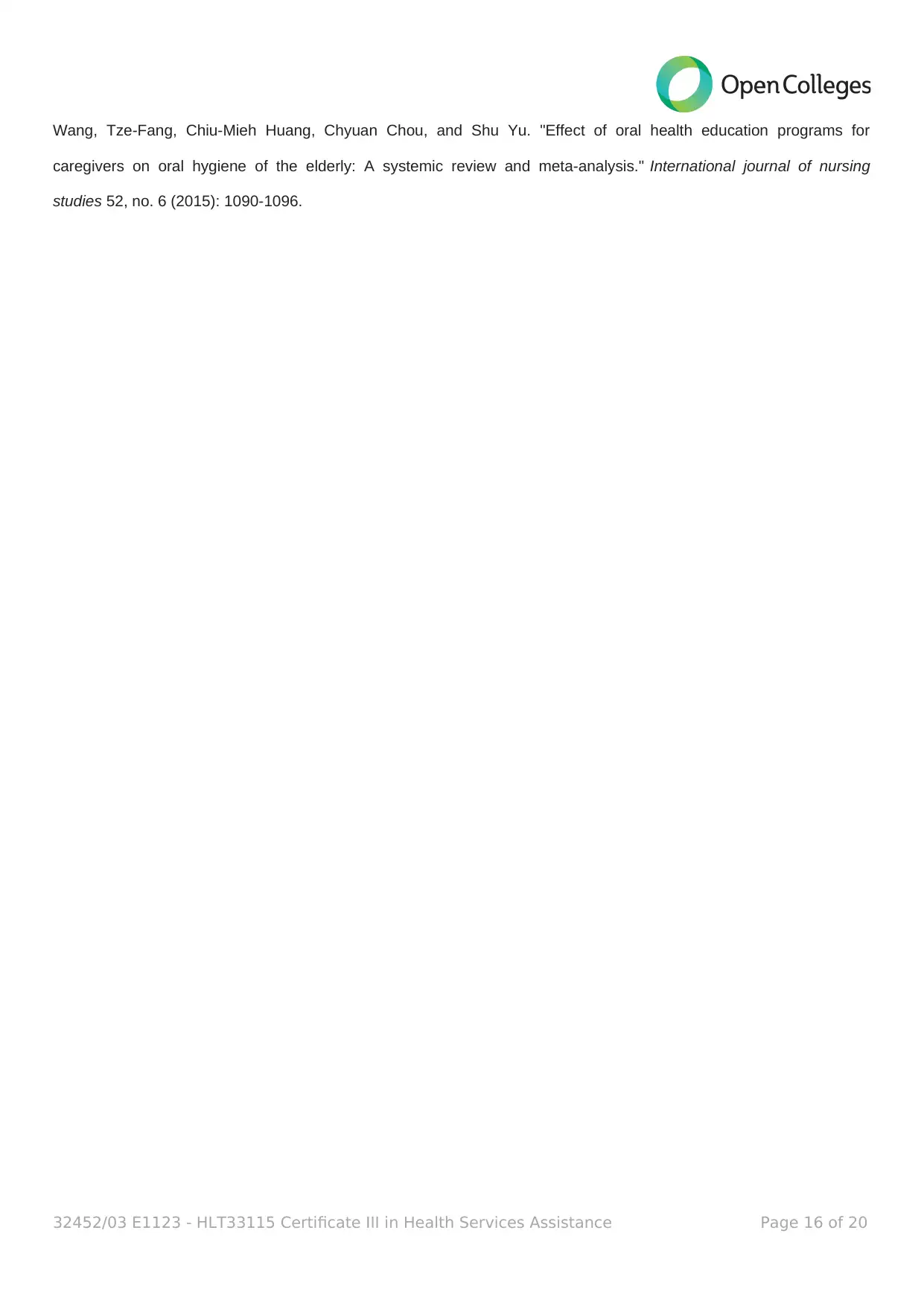
Wang, Tze-Fang, Chiu-Mieh Huang, Chyuan Chou, and Shu Yu. "Effect of oral health education programs for
caregivers on oral hygiene of the elderly: A systemic review and meta-analysis." International journal of nursing
studies 52, no. 6 (2015): 1090-1096.
32452/03 E1123 - HLT33115 Certificate III in Health Services Assistance Page 16 of 20
caregivers on oral hygiene of the elderly: A systemic review and meta-analysis." International journal of nursing
studies 52, no. 6 (2015): 1090-1096.
32452/03 E1123 - HLT33115 Certificate III in Health Services Assistance Page 16 of 20
Secure Best Marks with AI Grader
Need help grading? Try our AI Grader for instant feedback on your assignments.

4. Assessment Rubric
Below is a rubric that determines whether your answers and knowledge is satisfactory or
unsatisfactory.
To be deemed satisfactory, and to pass the assessment, you must complete the requirements for the
column that is titled ‘satisfactory’.
32452/03 E1123 - HLT33115 Certificate III in Health Services Assistance Page 17 of 20
Criteria Satisfactory Not yet satisfactory Feedback from
assessor
Client equipment Correctly identifies different
types of client equipment, their
purpose and basic use,
including how to check if it is
operational.
Cannot correctly identify
different type of equipment, their
purpose and basic use, including
how to check if it is operational
Client equipment Correctly identifies different
types of equipment, their
cleaning and storage
requirements.
Cannot correctly identify
different types of equipment,
their cleaning and storage
requirements
Client equipment Correctly match client
equipment with client needs.
Selects inappropriate equipment
for client care
Client consent Communicate effectively with
client in order to gain informed
consent
Does not communicate clearly or
gain consent.
Client comfort and
safety
Nominates ideas for promoting
client comfort and safety
throughout care procedures
Does not address client comfort
and safety needs.
Skin integrity Can identify risks to skin
integrity during procedure and
nominate risk control
measures
Does not identify risks to skin
integrity, and/or cannot
nominate appropriate risk
control measures
Client care Respond appropriately if a
client falls during care
procedures
Does not respond appropriately
if a client falls during care
procedures.
Oral hygiene Accurately identify factors
which factors can impact on
the oral health of clients,
including consequences
Does not accurately identify
factors which can impact on oral
health, or consequences of these
factors
Overall assessment expectations
Word counts As per tasks.
Plagiarism All the student’s work is original and sourced where appropriate.
Referencing Appropriate referencing conventions are used.
Below is a rubric that determines whether your answers and knowledge is satisfactory or
unsatisfactory.
To be deemed satisfactory, and to pass the assessment, you must complete the requirements for the
column that is titled ‘satisfactory’.
32452/03 E1123 - HLT33115 Certificate III in Health Services Assistance Page 17 of 20
Criteria Satisfactory Not yet satisfactory Feedback from
assessor
Client equipment Correctly identifies different
types of client equipment, their
purpose and basic use,
including how to check if it is
operational.
Cannot correctly identify
different type of equipment, their
purpose and basic use, including
how to check if it is operational
Client equipment Correctly identifies different
types of equipment, their
cleaning and storage
requirements.
Cannot correctly identify
different types of equipment,
their cleaning and storage
requirements
Client equipment Correctly match client
equipment with client needs.
Selects inappropriate equipment
for client care
Client consent Communicate effectively with
client in order to gain informed
consent
Does not communicate clearly or
gain consent.
Client comfort and
safety
Nominates ideas for promoting
client comfort and safety
throughout care procedures
Does not address client comfort
and safety needs.
Skin integrity Can identify risks to skin
integrity during procedure and
nominate risk control
measures
Does not identify risks to skin
integrity, and/or cannot
nominate appropriate risk
control measures
Client care Respond appropriately if a
client falls during care
procedures
Does not respond appropriately
if a client falls during care
procedures.
Oral hygiene Accurately identify factors
which factors can impact on
the oral health of clients,
including consequences
Does not accurately identify
factors which can impact on oral
health, or consequences of these
factors
Overall assessment expectations
Word counts As per tasks.
Plagiarism All the student’s work is original and sourced where appropriate.
Referencing Appropriate referencing conventions are used.

5. Units of Competency
This assessment meets the following units of competency:
CHCCCS002 Assist with movement
CHCCCS026 Transport individuals
HLTOHS004 Provide or assist with oral hygiene
All terms mentioned in this text that are known to be trademarks or service marks have been appropriately capitalised. Use of
a term in this text should not be regarded as affecting the validity of any trademark or service mark.
© Open Colleges Pty Ltd, 2016. All rights reserved. No part of the material protected by this copyright may be reproduced or
utilised in any form or by any means, electronic or mechanical, including photocopying, recording, or by any information
storage and retrieval system, without permission in writing from the copyright owner.
32452/03 E1123 - HLT33115 Certificate III in Health Services Assistance Page 18 of 20
This assessment meets the following units of competency:
CHCCCS002 Assist with movement
CHCCCS026 Transport individuals
HLTOHS004 Provide or assist with oral hygiene
All terms mentioned in this text that are known to be trademarks or service marks have been appropriately capitalised. Use of
a term in this text should not be regarded as affecting the validity of any trademark or service mark.
© Open Colleges Pty Ltd, 2016. All rights reserved. No part of the material protected by this copyright may be reproduced or
utilised in any form or by any means, electronic or mechanical, including photocopying, recording, or by any information
storage and retrieval system, without permission in writing from the copyright owner.
32452/03 E1123 - HLT33115 Certificate III in Health Services Assistance Page 18 of 20
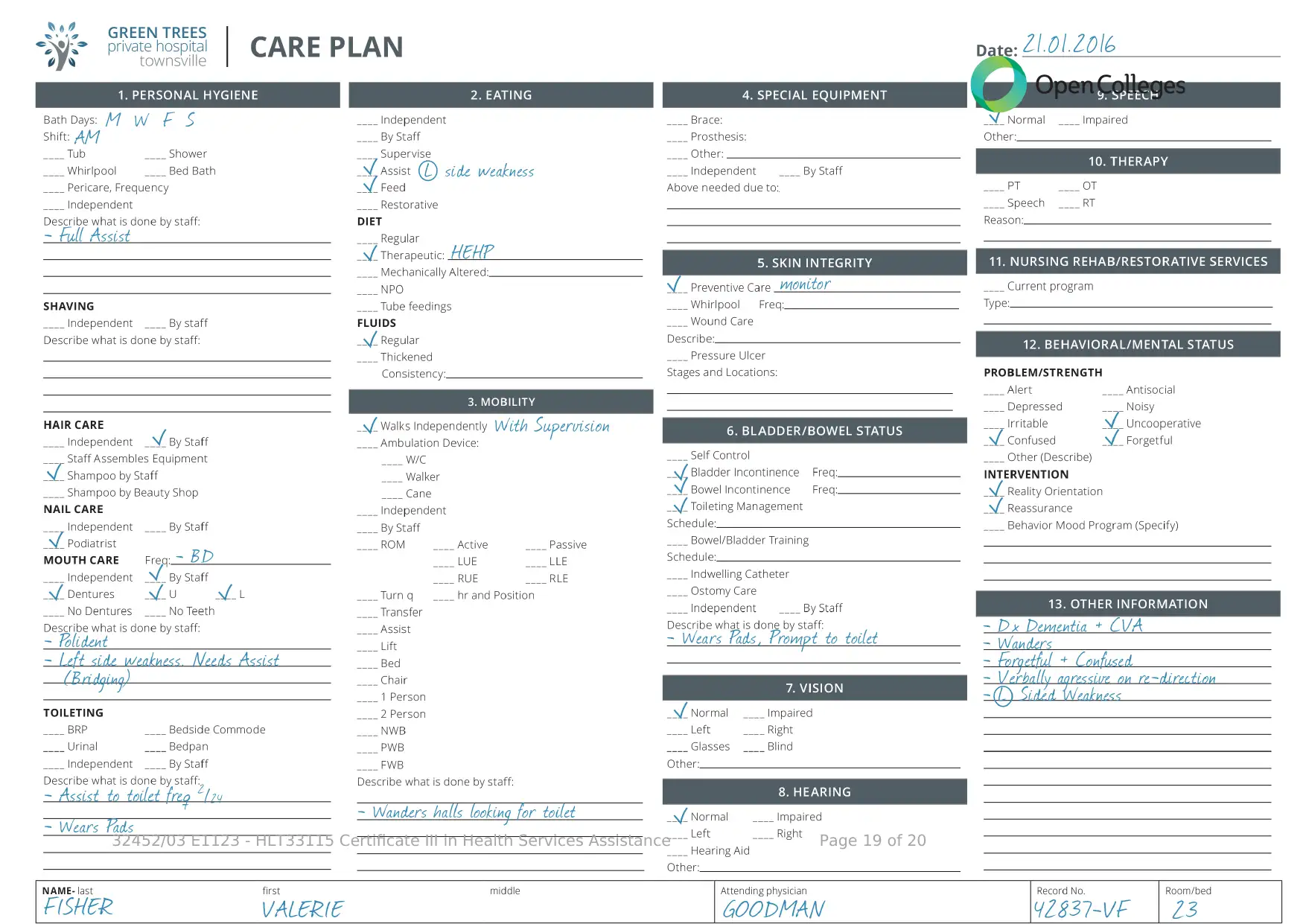
32452/03 E1123 - HLT33115 Certificate III in Health Services Assistance Page 19 of 20
Paraphrase This Document
Need a fresh take? Get an instant paraphrase of this document with our AI Paraphraser
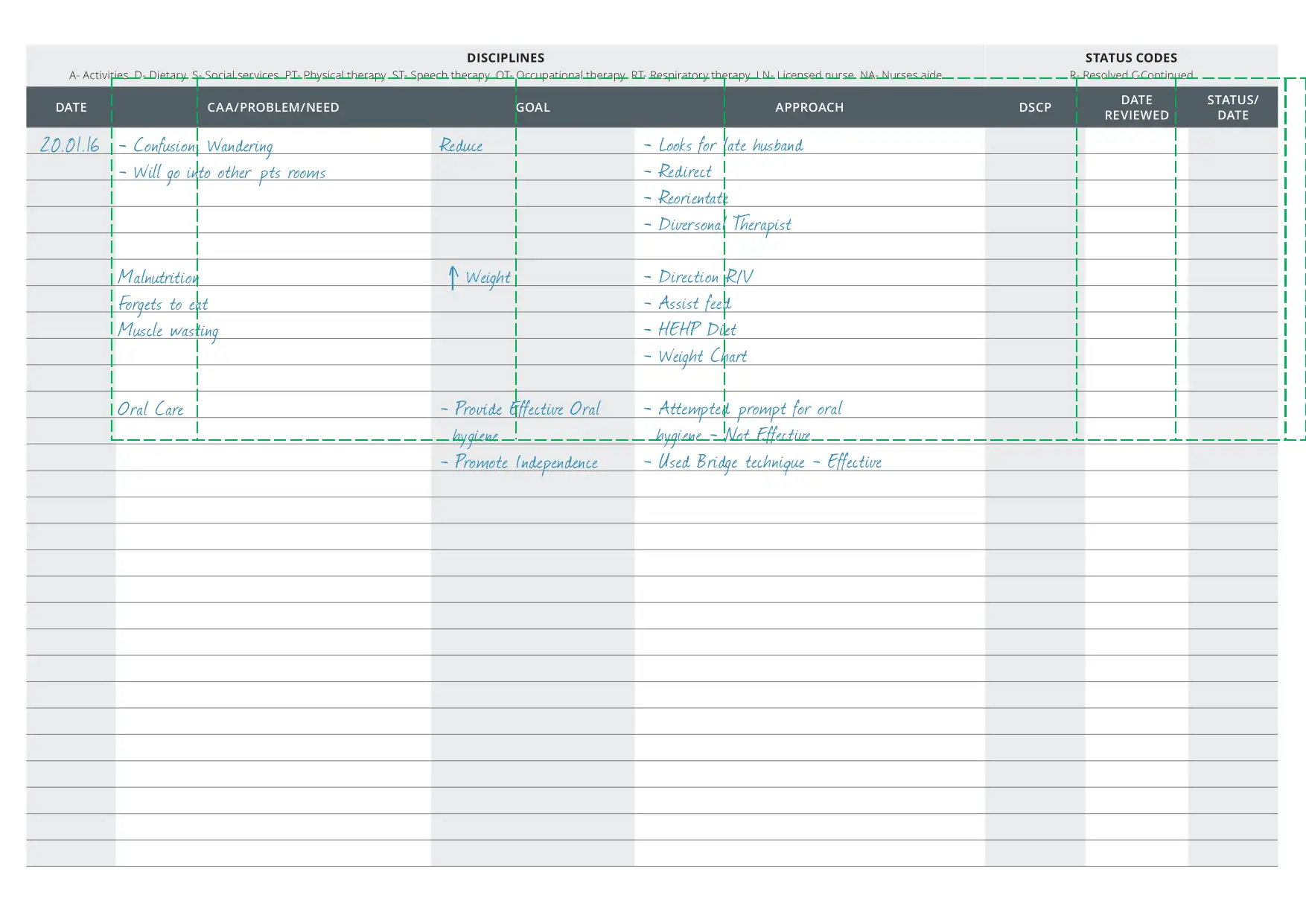
1 out of 20
Related Documents
Your All-in-One AI-Powered Toolkit for Academic Success.
+13062052269
info@desklib.com
Available 24*7 on WhatsApp / Email
![[object Object]](/_next/static/media/star-bottom.7253800d.svg)
Unlock your academic potential
© 2024 | Zucol Services PVT LTD | All rights reserved.





